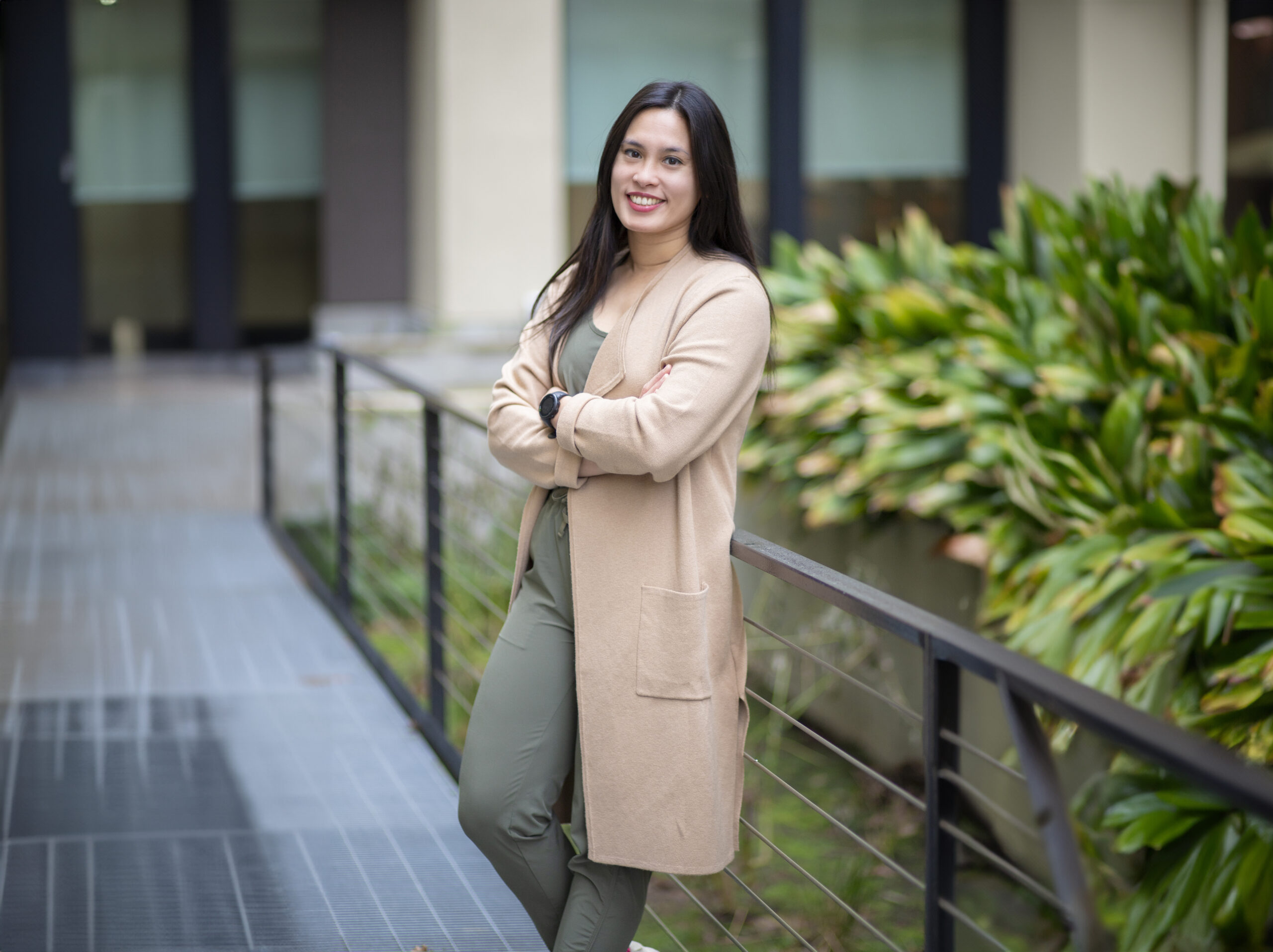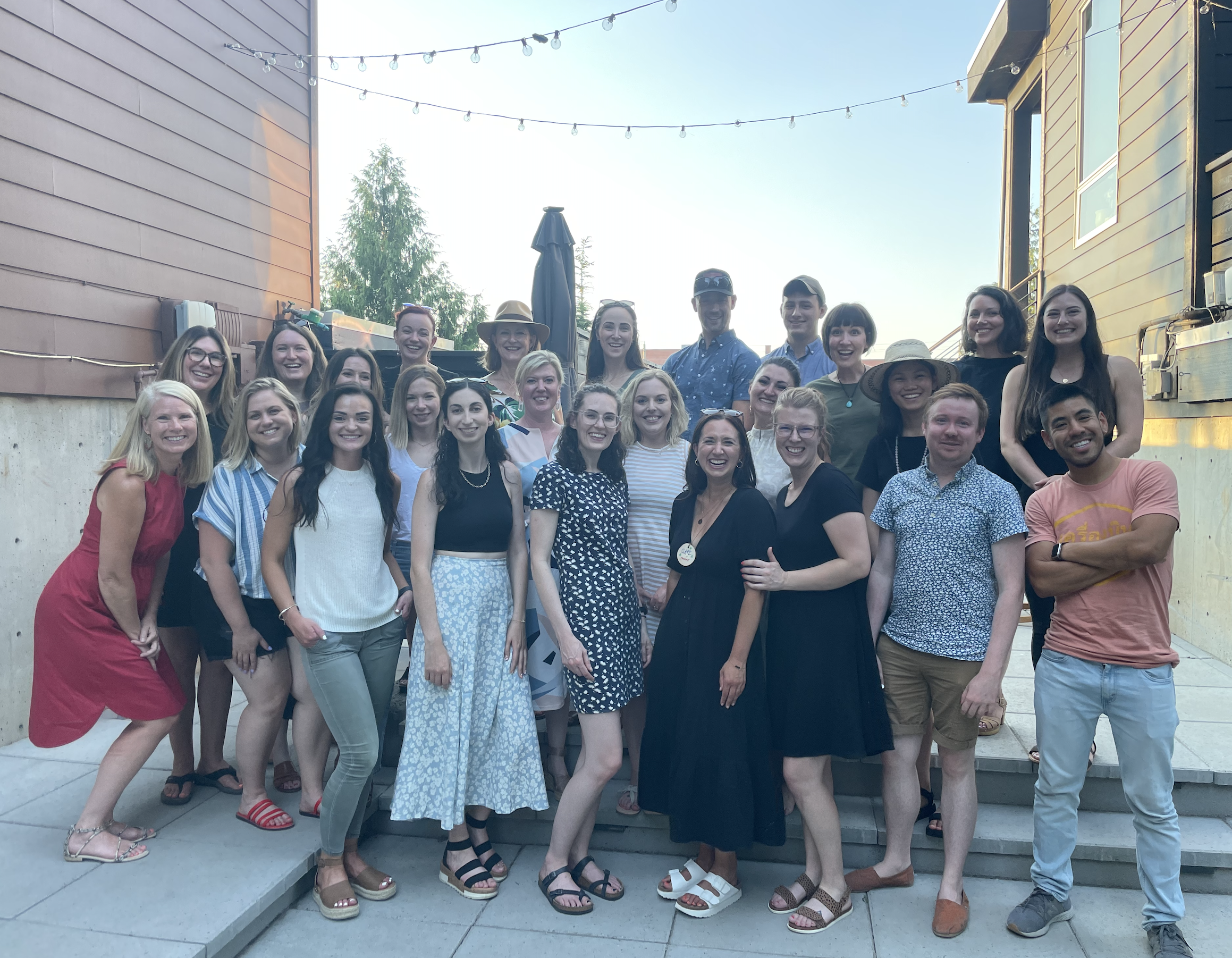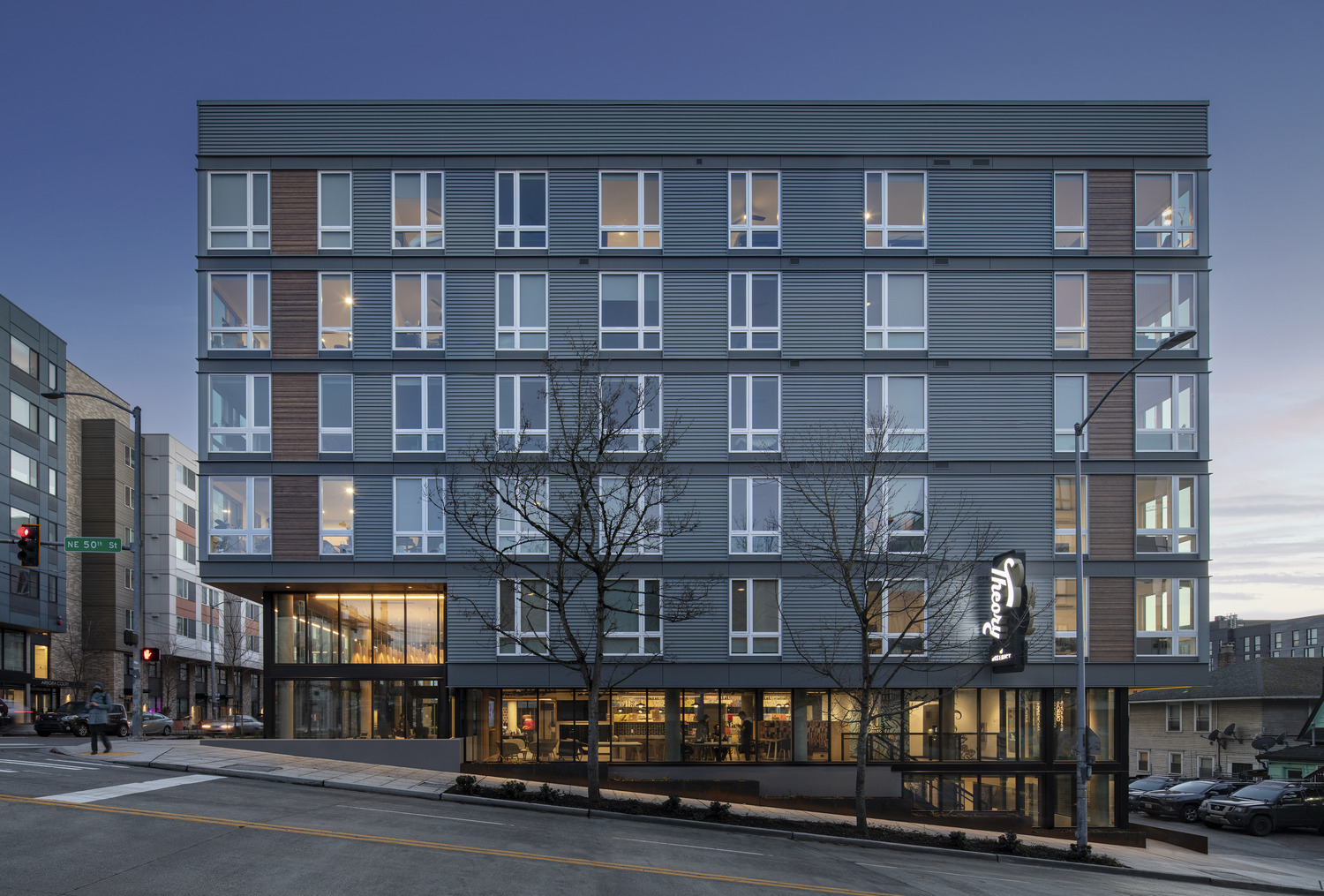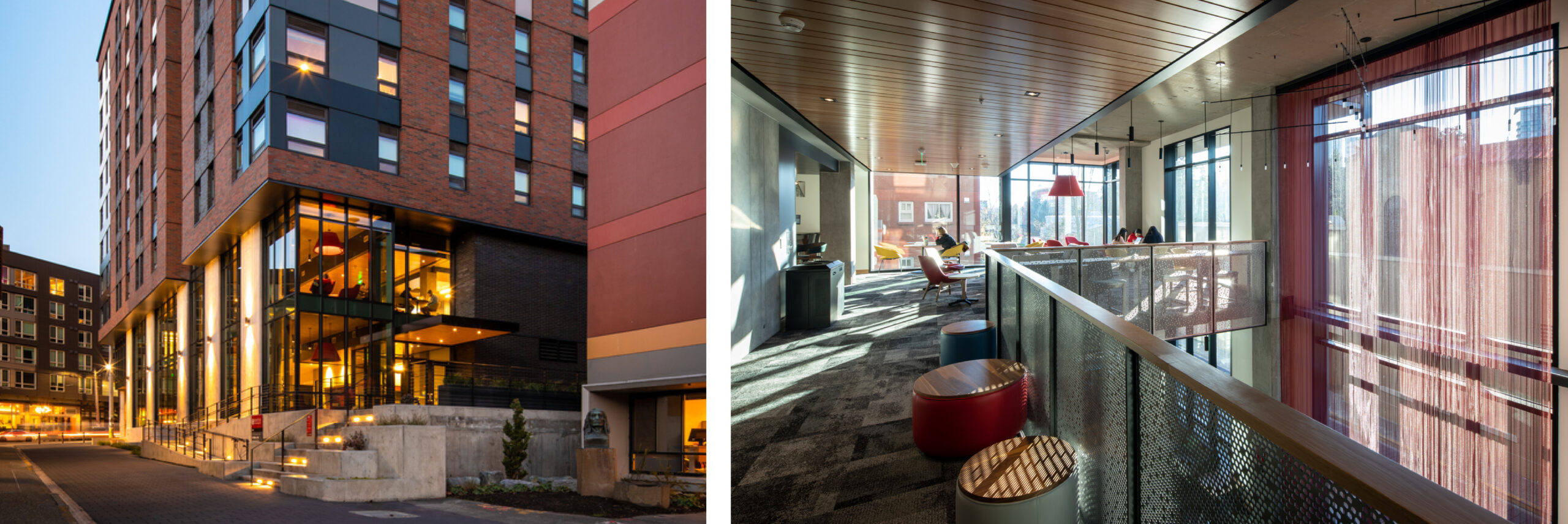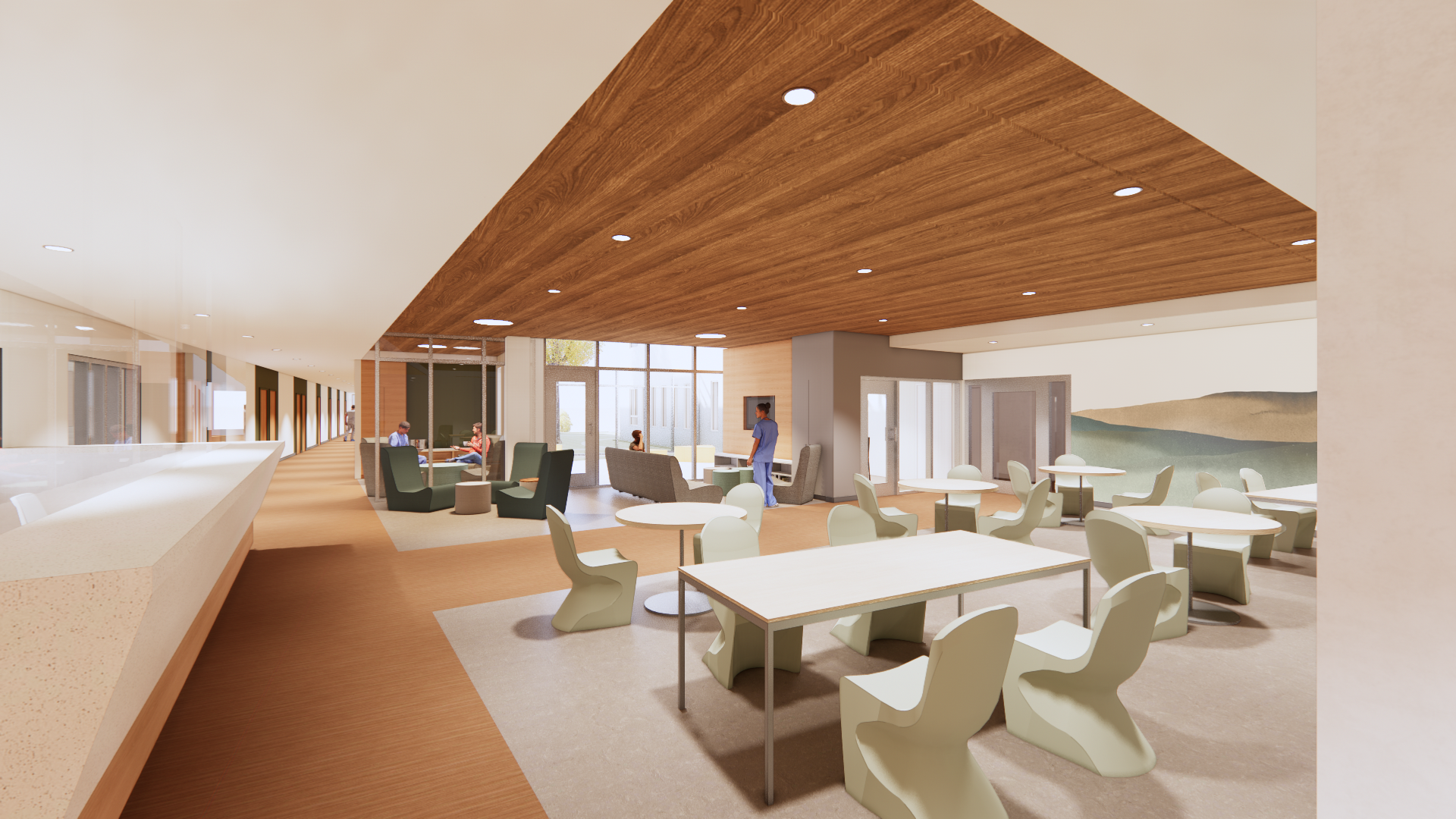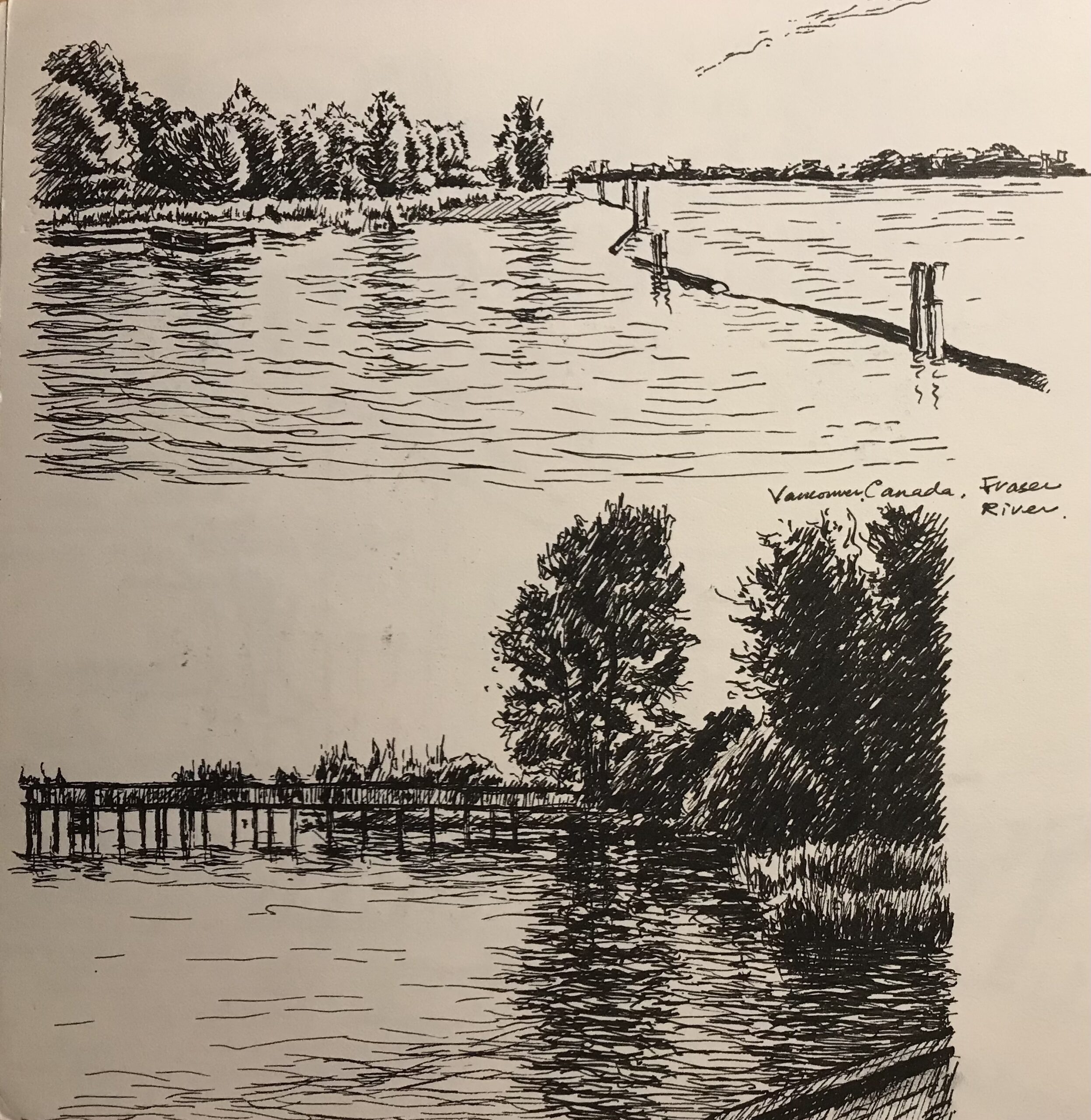Amanda Lunger wears many hats and has lived just as many lives. Recently, she was promoted to the role of Sustainability Advocate. Reflecting on her journey to this new position, Amanda sat down to discuss sustainability, career advice, and how her final studio project at the University of Oregon – a passive house affordable housing project – led to her being recruited to work at Ankrom Moisan.
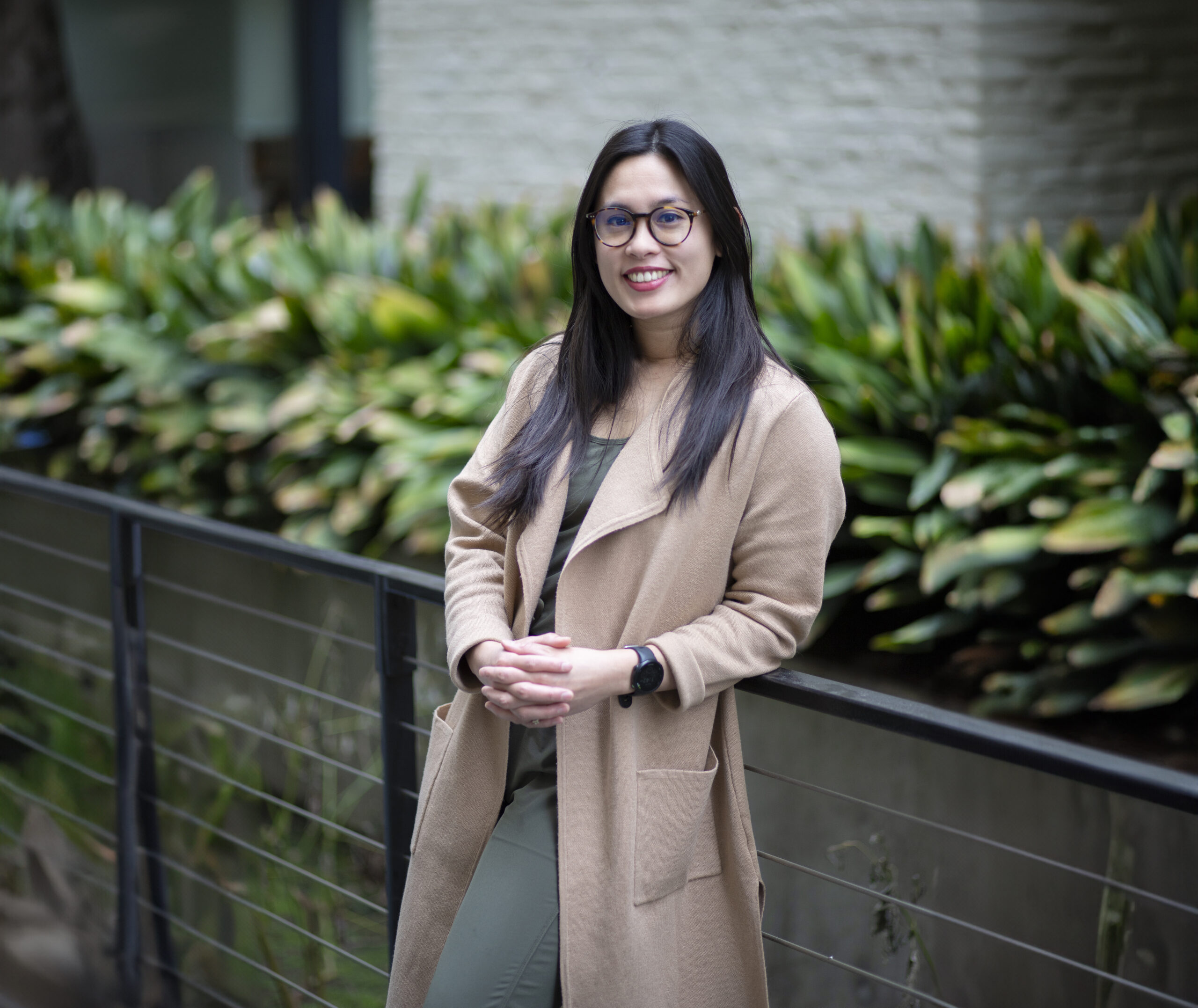
Amanda outside of Ankrom Moisan’s Portland office.
Q: You were recently promoted to a sustainability role within the practice team. What can you tell me about that?
A: Well, we’ve had different groups in the office before to try and push sustainability initiatives and ensure there is adequate education about the topic, but now we’re taking the extra step of having a dedicated role that’s responsible for setting and executing goals and initiatives related to the sustainability of the firm. In this sense, I work in an overhead capacity to develop internal processes and education opportunities to further our sustainability efforts, and then also support projects as the need arises. It entails helping people set sustainability goals, research different technologies, and assisting with the selection of appropriate sustainability certification programs for projects. Eventually, I’ll assist with business development, telling the story of Ankrom Moisan’s sustainability expertise on our website and in RFPs, helping designers feel prepared to talk to clients about sustainability.
Q: What does sustainability mean to you?
A: I think to me, sustainability is recognizing the interconnectedness of all the decisions that we make as humans and understanding that those decisions have implications for all the other living things on this planet, as well as for future generations and even our future selves. Personally, my values and beliefs around sustainability are inherently tied to my spiritual beliefs, because I believe that all life has intrinsic value and that we have a moral obligation to look out for the wellbeing of all living things on this planet.
Q: What do you hope to accomplish in your new role?
A: I hope to help create and push forward a culture at Ankrom Moisan where sustainability is just part of everything we do. Many different things might have to happen to get us there, but if Ankrom Moisan can be known as a firm with expertise in sustainability, and if our staff can really feel that, then that’s a good sign of success to me.
Luckily, firm leadership has decided that this is the year to really start prioritizing sustainability. I am so excited to be a part of that effort and to help with that push while we have the momentum and support of leadership. It feels like a good time to be stepping into this role.
Q: Aside from sustainability-driven efforts, what is your favorite type of work to do? Why?
A: I really love the work I’ve done here at Ankrom Moisan with our mission-driven nonprofits. Specifically, working on affordable housing with REACH has been very rewarding because I really respect the mission of those clients. What they’re trying to do is better the lives of the people they serve.
I also enjoyed being in more of an overhead support position with the transition to BIM, and now again with my new sustainability role. I’ve realized over the course of my career that I get the greatest fulfillment from helping my coworkers and making their lives easier. I feel very appreciated in those kinds of support roles – they’re what I enjoy most.
Q: How long have you been at Ankrom Moisan?
A: I’m a boomerang employee. Initially, I worked here for two years – from 2013 to 2015 – as an architect, but then left Ankrom Moisan to work at a few other offices. I came back in February of 2019 to work as a BIM specialist because I wanted to make a lateral switch in my career. For this go around, I guess I’ve been here a full five years. I’m entering my sixth year.
Q: What brought you here?
A: This is a fun story. So, I was at the University of Oregon in my final year of the architecture program. I was doing a terminal studio, which encourages students to focus their final project on an area that’s of special interest to them. At the time I had gotten really into sustainability and passive house because of one of my professors, Professor Alison Kwok. I went through a whole intensive passive house training program and got my Certified Passive House Consultant Accreditation (CPHC). For my final studio, I was looking specifically at the applicability of passive house to affordable housing and how mission-driven nonprofits could really benefit from the deep energy savings of passive house, since they’d be able to save money on building operations and funnel those funds back into their programs for clients and the people who live in their buildings. So that’s what I designed. I picked a site in San Francisco and a fake client – a nonprofit affordable housing developer – and I ran an energy model on it, demonstrating how it could meet the passive house standard.
Isaac Johnson ended up being one of my reviewers during my final review. I was really interested in Ankrom Moisan at the time because of the work the firm was doing with affordable housing. Well, after graduation I was working with another firm when I got a call out of the blue from Isaac Johnson. He said something like “Hey, so I remember reviewing your final studio project, and we basically have that project at Ankrom Moisan now. Do you want to come work for us?” He was talking about Orchards at Orenco which is a REACH Development affordable housing project that was pursuing passive house standards, so obviously I said yes. It was really cool coming out of college and working on a project with the exact same sustainability goals that I was passionate about.
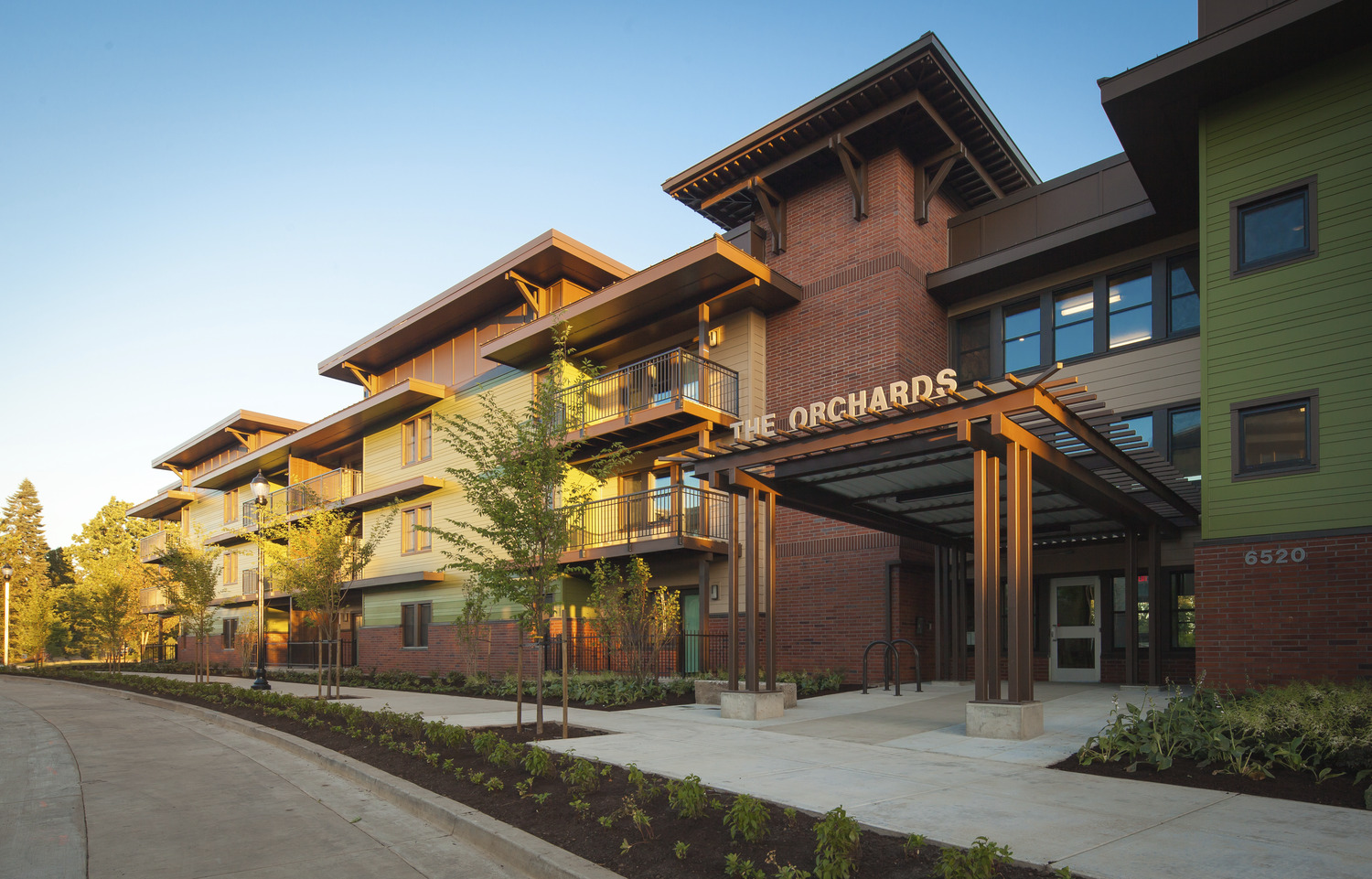
Orchards at Orenco.
Q: What was it like when you first started out?
A: We were still on Macadam. It wasn’t the nice office we have now. I remember it felt a little more hodgepodge, but also like there were distinct families within the office. I worked in the basement – there were very few of us down there. We had our own kitchen and conference room; it was like our whole world. It was a very tight-knit group of people because of that. A lot of the young professionals were also recent college graduates like me. It was really nice having that community to commiserate with and co-mentor together.
I was part of two distinct families. There was Jeff Hamilton’s team in the basement, and then there was the recent college graduate family that was spread across different project types. Elisa Zenk and Stephanie Hollar started around the same time I did and were part of that cohort. We became really close friends, along with Elisa’s now-husband who was also part of that cohort. It was a cool way to learn about stuff that was happening across the office, because Elisa would be working on student housing, Tim on something else, and Will on something completely different as well. It made us feel more connected to the firm.
There were also a lot of recreation opportunities. We had a volleyball team; we would play soccer during lunchtime out at the park. It was a great community.

Amanda with Elisa Zenk and Stephanie Hollar on the rooftop of Ankrom Moisan’s Portland office.
Q: Since starting here, how have you grown professionally?
A: My biggest area of growth has been figuring out how to collaborate with other people. You can’t just rely on yourself. You have to work with other people if you want the best results. Knowing your coworkers’ talents and who to reach out to is a very soft skill that nobody really talks about, but I think it’s so critical to the success of the work that we do. As buildings get more complex and we want to use more and more data to inform our designs, having good collaboration becomes all that much more important.
Q: Since you started here, what has the biggest change in the firm or industry been?
A: It has to be the COVID-19 pandemic. That changed the way we work and the way that we collaborate. It also changed the culture of the firm a bit. I think one of the good things that come out of it is that there’s a greater understanding of work-life balance and mental health, and a greater awareness that those things should be prioritized. Sometimes it can feel like the division between work and home doesn’t exist as much, but I think in general, we’re just more flexible about how we work.
Q: What’s your favorite thing about working here?
A: My favorite thing about working at Ankrom Moisan is the people. I’ve found the across the board, in all echelons and experience levels, in all project types and studios, we just have great people. There’s so much support from everyone, not only because of what you can do professionally, but also just because of who you are as an individual. The people I’ve worked with have been excellent coworkers who take a personal interest in you.
Q: What inspires you?
A: It’s definitely nature. I know that sounds cliché, but you won’t find any better designs that what is found in nature. Any system you’re trying to optimize has been done in nature.
My favorite natural space is probably Milo McIver State Park on the Clackamas River. My husband and I are avid disc golfers, which is probably one of the reasons I love that place so much. It’s so lush and green and has such tall trees. There’s also the river there, which is very pretty. It’s so cool to see how the flow of the Clackamas changes seasonally.
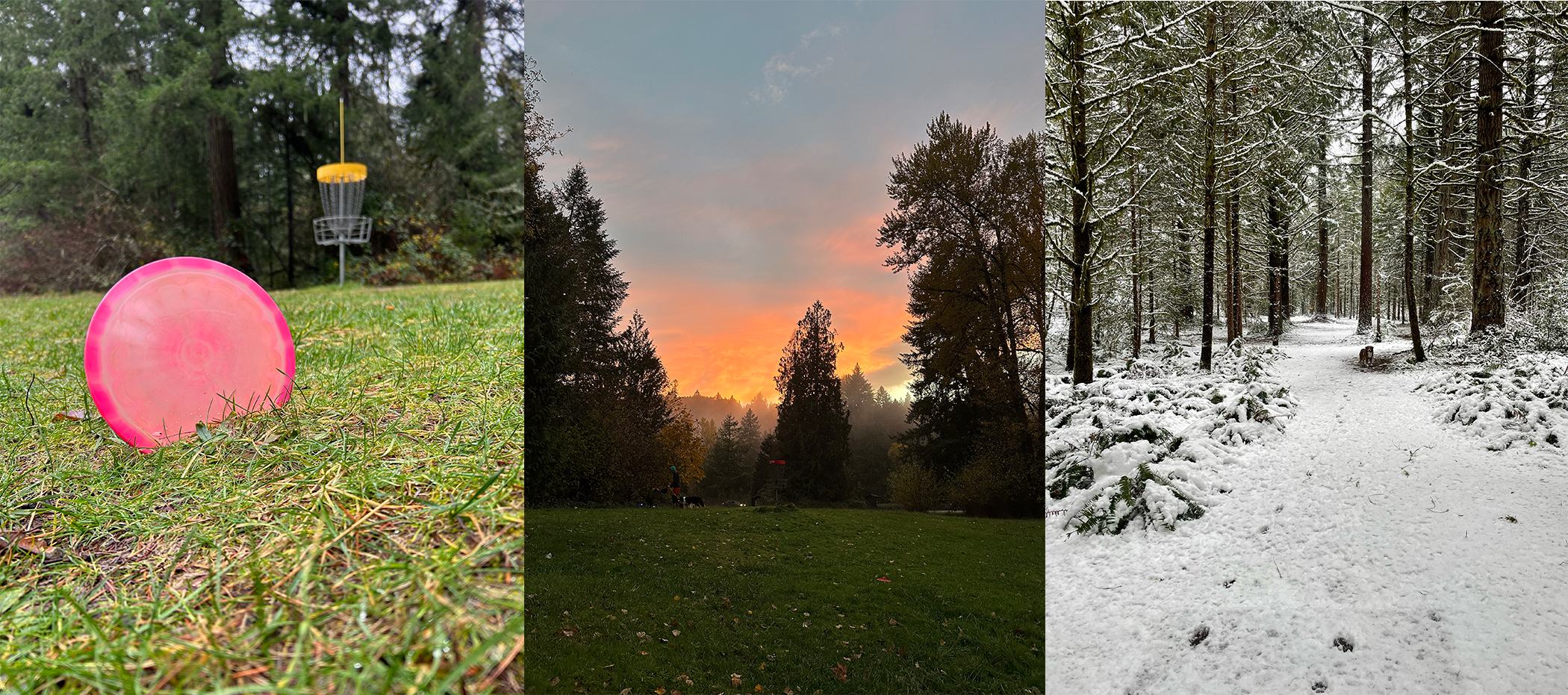
Milo McIver State Park throughout the seasons.
Q: What advice do you have for young professionals who are just starting out in their careers?
A: Don’t isolate yourself. Find your tribe. Find your support system of both other young professionals and more experienced people who you can learn from. It makes a huge difference. It helps keep you motivated and wanting to improve yourself. It also helps with mental and emotional health, knowing that you have a support person who you can grab coffee with or step outside to talk about the rough day you’re having.
Get in the habit of taking a personal interest in getting to know your coworkers. Don’t be that person who looks the other direction when you’re walking down the hallway who tries to avoid saying hello. If you’re genuinely interested in your coworkers, it’s a lot easier to pick up the phone and call them about something or send them a random message on Teams. It can even become something that you look forward to if you have coworkers that you enjoy chatting with.
Lastly, I would say, don’t be afraid to ask questions. Nobody is expecting you to be an expert. Take advantage of that by asking questions and learning from people.

By Jack Cochran, Marketing Coordinator
Ankrom Moisan’s Mission and the Emergence of Our Why: Part 1
This is part of a series on the origin of Ankrom Moisan’s mission and vision, our purpose for doing what we do, and the values by which we work. Read Part 2 here.
During the Great Recession work was very slow, and our founder Stewart Ankrom retired. With time and transitional change, we found ourselves looking inward, contemplating our purpose and what makes us unique. Tom Moisan, a founder and the president, held a fall retreat to better determine what we stand for, and where we wanted to go.
This retreat was the beginning of a more than decade-long journey to capture the collective values that make our firm a great place to work. Tom and seven managing principals met over and over to put words on the wall, defining and refining their deeper meanings, especially: “listening”, “learning, and “empowerment’. From these early sessions, a working list of seven values and our mission (our What) emerged:
We design places where people and communities thrive.
Between 2014 – 2017 we saw high growth, and we were using our values and our mission as a touchstone to orient new employees and attract new clientele. During that time Tom Moisan, our second founder retired, and Dave Heater, Managing Principal of the Seattle office, stepped into the role of President. With the fast and furious growth came the realization that Ankrom Moisan needed to relook at the mission and values and see if they truly communicated the vision and direction of the firm.
Around this time President Dave Heater read the book Find Your Why by Simon Sinek; “As I started reading the book, I got so excited because I realized that it was a process that was based on storytelling. And I thought, ‘This is the perfect process for Ankrom Moisan to uncover what is at our core, what is our driving purpose, and what makes us unique in the world.’”
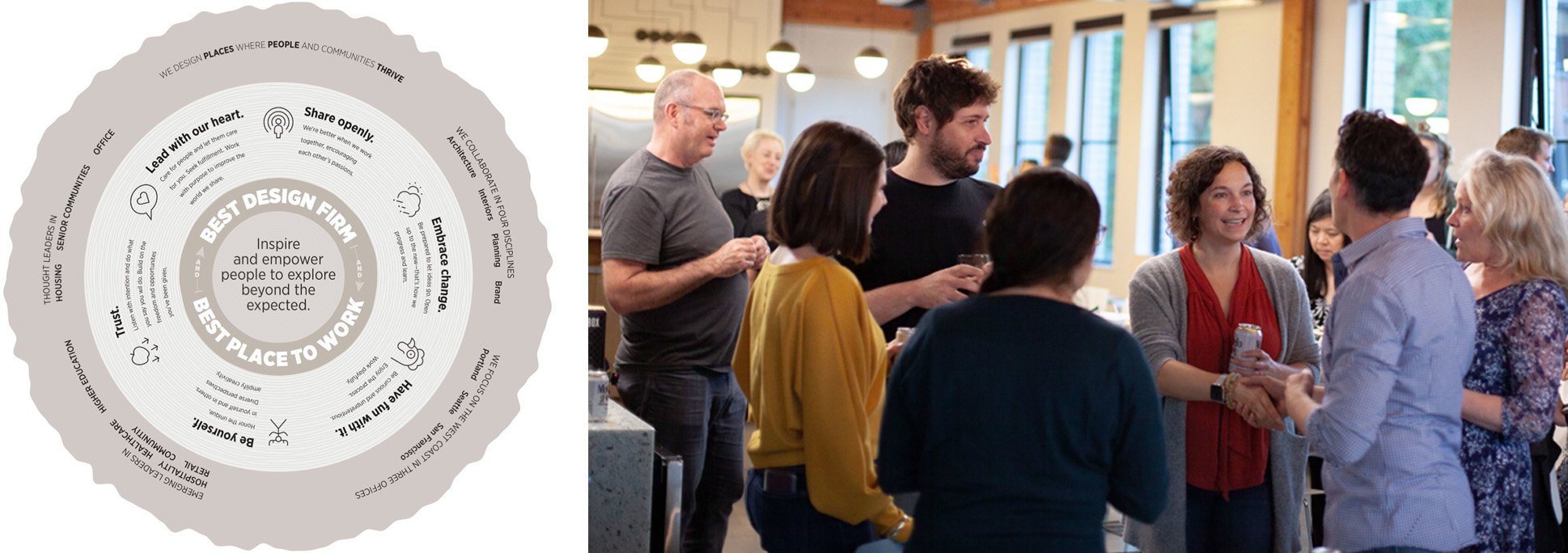
We began the Why process in 2018, with thirty of us participating in a two-day retreat. We were a mix of leaders, designers, marketing, and accounting staff: a large cross section of the firm. The process began with an emphasis on storytelling and each person defining their own personal WHY for their life. Stories illuminated motivation, inspiration, and perseverance. The Why statement is meant to bring awareness to “why we get out of bed to come to Ankrom Moisan each day”. Rich, meaningful, personal stories were revealed throughout the retreat, and everyone left feeling energized and uplifted.
As one of the leaders participating in the retreat, Jennifer Sobieraj Sanin, Managing Design Principal, marvels that, “it’s incredible that a large group of people sharing stories of experiences at the firm were finding commonalities while crafting the Why. Usually, it takes two years to do anything, and this was successful in two days.” The Why we came away with during that retreat was unanimously agreed upon:
Inspire and empower people to explore beyond the expected.
Nandita Kamath, Associate Architect, has been with us for over a decade, and she participated in the larger listening sessions as well as some of the smaller workshops over the years. She adds another benefit of the sharing and storytelling, “It was great to hear others’ experiences about starting at AM, and what was great about coming into the firm. It gave us a chance to reflect on why we are here, doing what we’re doing. It has been an inclusive experience.”
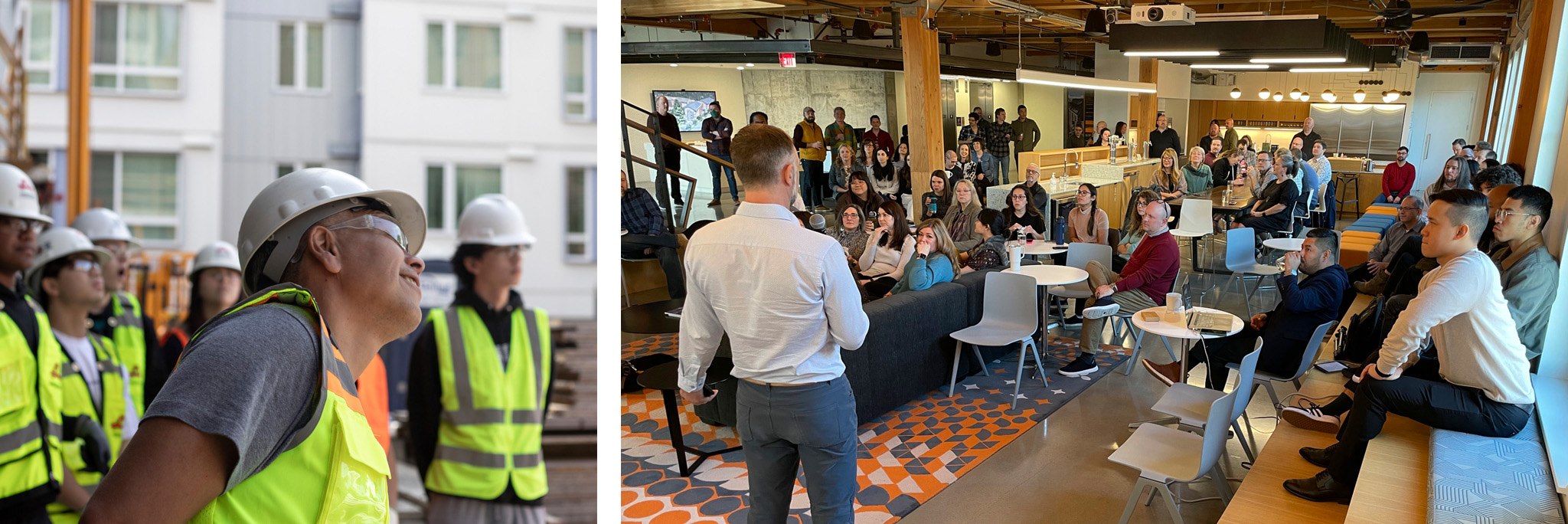
Among the stories told were general themes of coworkers having each other’s backs, shared memes and uplifting messages while facing stressful deadlines. Having a good time, encouraging each other when needed, and being respectful of each other’s lives show that mutual support and camaraderie really stand out as reliable methods of empowering and inspiring each other. Nandita shares that the Why comes up regularly in her day-to-day work, and though it can be tough to put into practice, mentorship is a great example of putting the Why into play, as the benefits of mentorship, ideally, can go both ways. It is an ongoing opportunity to have an introspective look at how we operate.
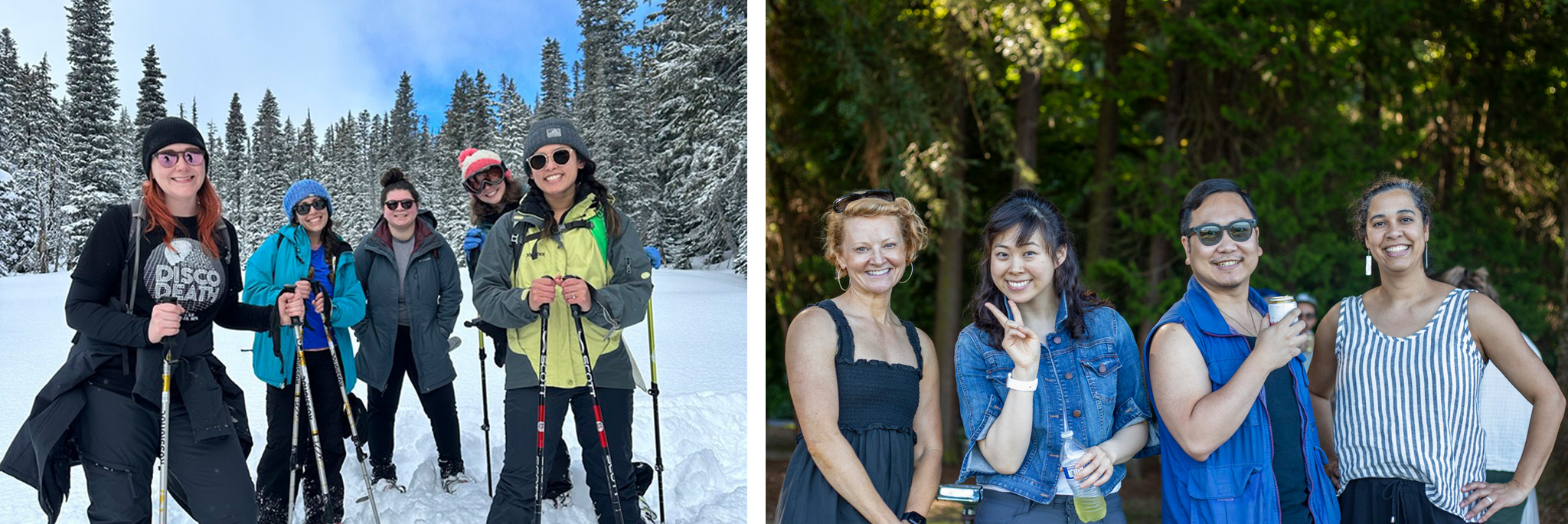
Jennifer says that to inspire and empower as a leader is more top-of-mind, and that it’s about making sure you play to people’s strengths, ensuring that they are in a place to succeed, and finding ways to remove obstacles for more confidence and autonomy as needed. And on the client-facing side of things, “it’s often about encouraging your clients to not ‘rinse and repeat’. Let’s try something new, a little different, out of the box.”
Our Why continues to resonate, and is present in our everyday work, while interacting with our clients and our coworkers. We are pushed to go further and be better by living by the mission and the Why we have defined for ourselves.

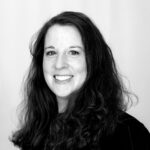
by Kerstyn Smith Olson, Content Coordinator
Getting Involved in the Interior Design Industry
Three members of our interiors department, Roberta Pennington, Clare Goddard and Jessica Kirshner, discuss their experience with the International Interior Design Association (IIDA) and how their involvement in the organization has propelled their professional careers.

Left to right: Jessica Kirshner, Maddy Gorman, Clare Goddard, Roberta Pennington, and Jenna Mogstad at an IIDA event
Q: What’s your experience with IIDA? How were you involved?
Roberta: I have been an IIDA member since graduating (the second time) in 2001. My first event was an awards breakfast at the Governor Hotel in PDX also in 2001; I didn’t know anyone, but the Members were super friendly and welcoming.
I attended MANY events consequently then stepped up my volunteer time to the Board in 2009. I dove into the President Elect role during a time when Members, including myself, did not have jobs. IIDA gave me the stability and connection I was missing during the year I was unemployed.
After my Presidency, I stayed on as a Chapter Advisor and most recently came back to serve on the Board with the Advocacy team. I’ve been involved in one way or another with finding legal recognition for commercial interior design in Oregon since 2003, and I want to continue to be a part of the momentum gaining speed nationally. It’s an exciting time for interior designers on the legal front.
Clare: I have been involved on the board for a little under 5 years (started October of 2018) first as the VP of Communications and then moved into President-Elect/President/Past President roles.
Jessica: I started with IIDA in college, I was on the student board as the fundraising chair. Once I graduated and was hired on full time at AM, I joined the Oregon Chapter Board as the Director of Social Media and I have held this position for the past 2 years.

Q: How did membership in IIDA benefit you professionally?
Roberta: Networking! I can go anywhere locally and nationally, and a complete network of design leaders are available to tap.
I became much more active during the Recession in 2009 when I stepped up to be President-Elect. The network of people on the Board were instrumental in getting my name to the top of a list of persons to hire when firms were not hiring. I’m very grateful to this group.
I also got to know women in the profession who were and still are my mentors and friends. Their experiences showed me having a child does not mean the end of my career. Women don’t have to “act like a man” to be taken serious. Speaking my mind does not make me a “bitch.” AND: I’m a very entertaining public speaker. Very liberating.
Clare: Prior to joining the board (and when I was in San Diego), I credit IIDA with connecting me to potential employers and creating a sense of community in a city where I knew no one. Joining the board here in Oregon has greatly improved my leadership and delegation skills. It has also helped me to create a sense of community here in Portland, beyond AM. I consider it a privilege to have served this design community on the board in helping to be the face of interior design for the state of Oregon. Being part of the board, in any capacity, is how I give back to the profession that I am so passionate about.
Jessica: I have been able to attend countless events that have both inspired me and helped me professionally. These ranged from forums to socials. Each event hitting on a different and important topic in our industry. It has also been a great networking opportunity that has allowed me to connect with people I wouldn’t have met otherwise.
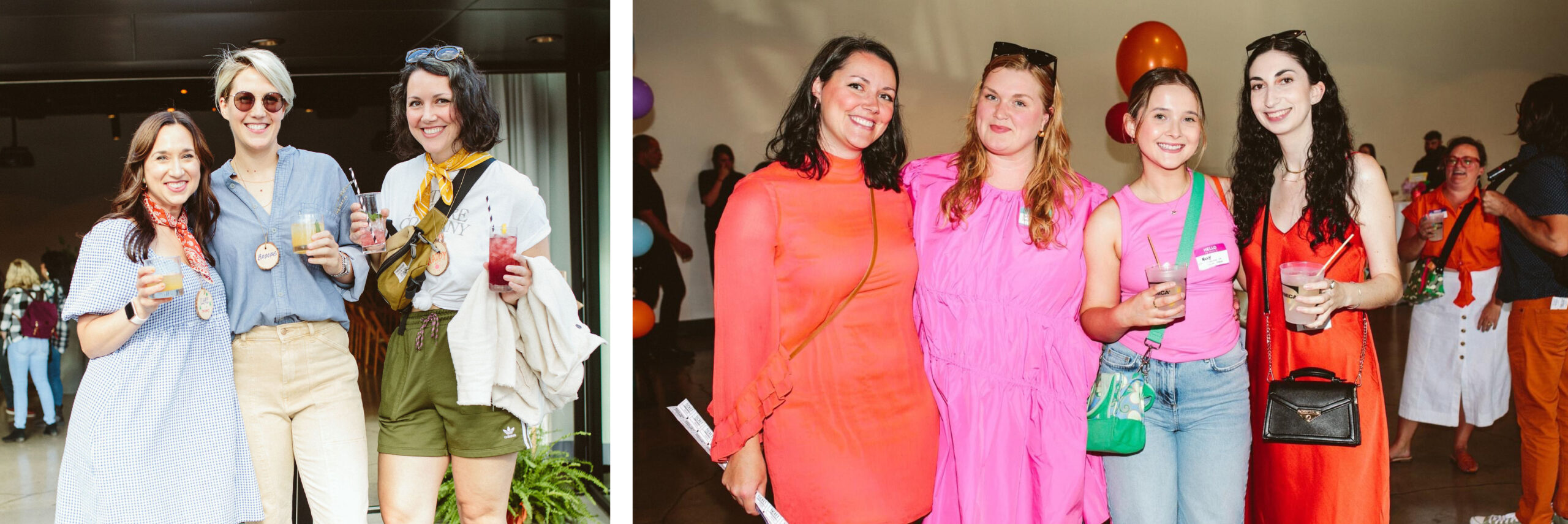
Q: What’s your most memorable moment from your time in IIDA?
Roberta: A standing ovation at the Annual Celebration 2010 at Ziba. I delivered my incoming President speech. I wasn’t sure I was coming in with the right message; that being “We’re not dead; we will get thru this Recession somehow.” When the room of people stood up, clapped, and cheered, I knew I was going to be okay. The CEO of IIDA National was there and told me she would never go on after me again. A real head-swelling moment.
Clare: That has to be the CLCs (Chapter Leaders Conferences) held in Chicago and regionally. I love getting to connect with leaders from other chapters across the US! It was amazing to learn from others and to make new friends. The CLCs will be what I miss the most post-presidency.
Jessica: I don’t necessarily have a specific moment but getting to serve on board with such amazing people has been so motivating. It’s helped me to grow in so many ways. I’m so thankful to have been on the board.
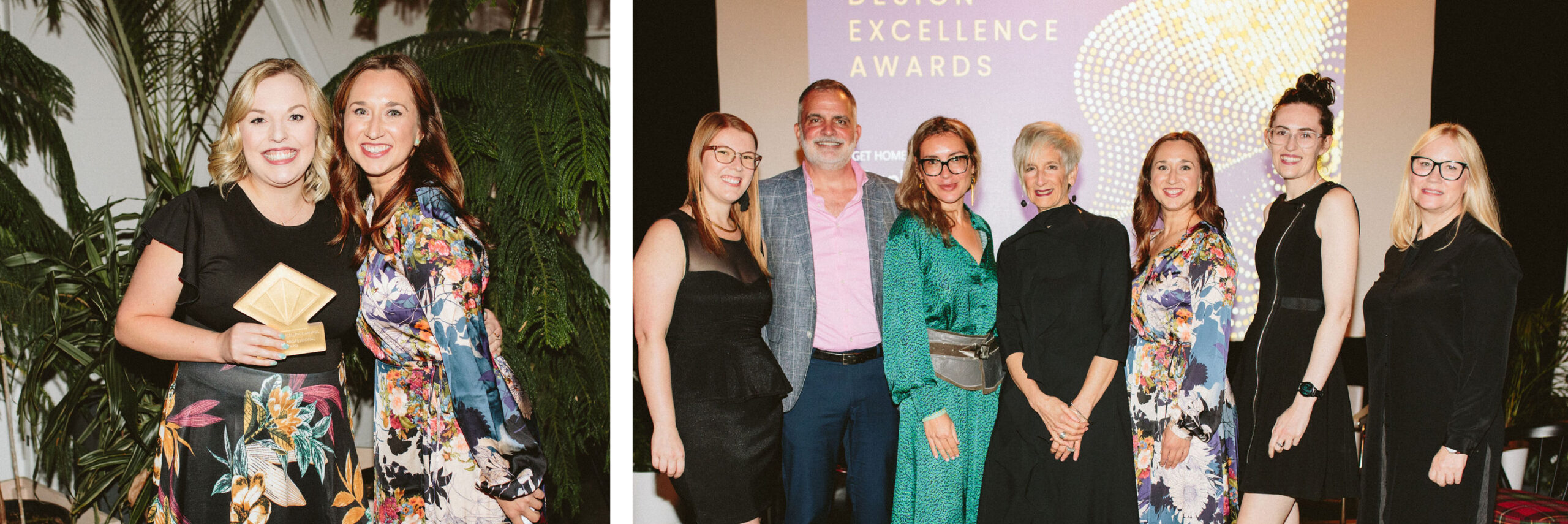
Q: How did AM support your involvement?
Roberta: In my Board involvement, AM has reimbursed annual dues as well as allocated time for volunteering. My current role as VP of Advocacy means I’m spending time meeting with committees, legislators, consultants, and peers often. I can keep my PTO for actual vacation time.
AM has also been an annual sponsor to the Chapter every year an employee has served on the Board. That sponsorship is instrumental in keeping the Chapter going.
Leadership has also written letters to legislators during recent pushes for legal recognition of interior design. This small act shows the value AM places on my education, experience, the NCIDQ, and what I bring to the table as a commercial interior designer.
Clare: AM is one of the more supportive firms in the state. They not only encourage employees to be on the board, but back up that support by paying for IIDA membership and providing 2 paid hours per week for board tasks for those serving on the board. I count myself very lucky to have such a supportive firm.
Also, I think because of that support, Ankrom has had consistently the highest number of people serving on the board (this past year, there were five AM’ers on the board). We always joke that House Ankrom is taking over. Additionally, not only has AM supported individual board members, but they have also lent us the office for multiple board retreats and board events.
Jessica: AM was completely supportive throughout my time on the board, as well as everyone else in the interiors department who was on the board. The interiors leadership team encouraged us to attend IIDA meetings and events and would even show up to events in support.
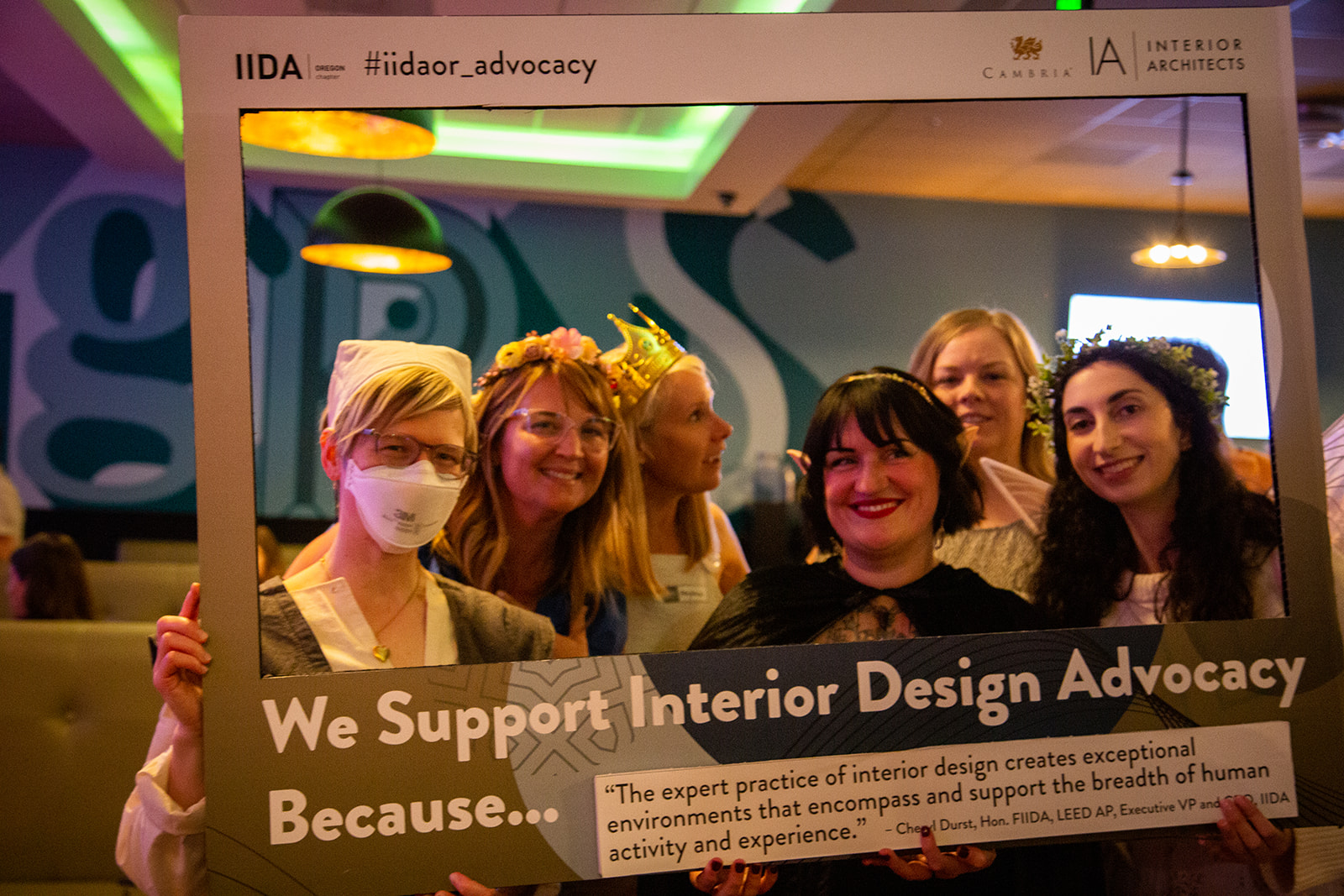
Discussing Pride with Dave Heater
AM President Dave Heater talks to Dani Murphy about Pride.
Get to Know Our Student Housing Leaders
Two of our Student Housing studio leaders, Alissa Brandt and Matt Janssen, give us insight into the unique joys and challenges of designing student housing. They touch on Gen Z expectations, trend forecasting, sources of inspiration and what’s next for student housing.
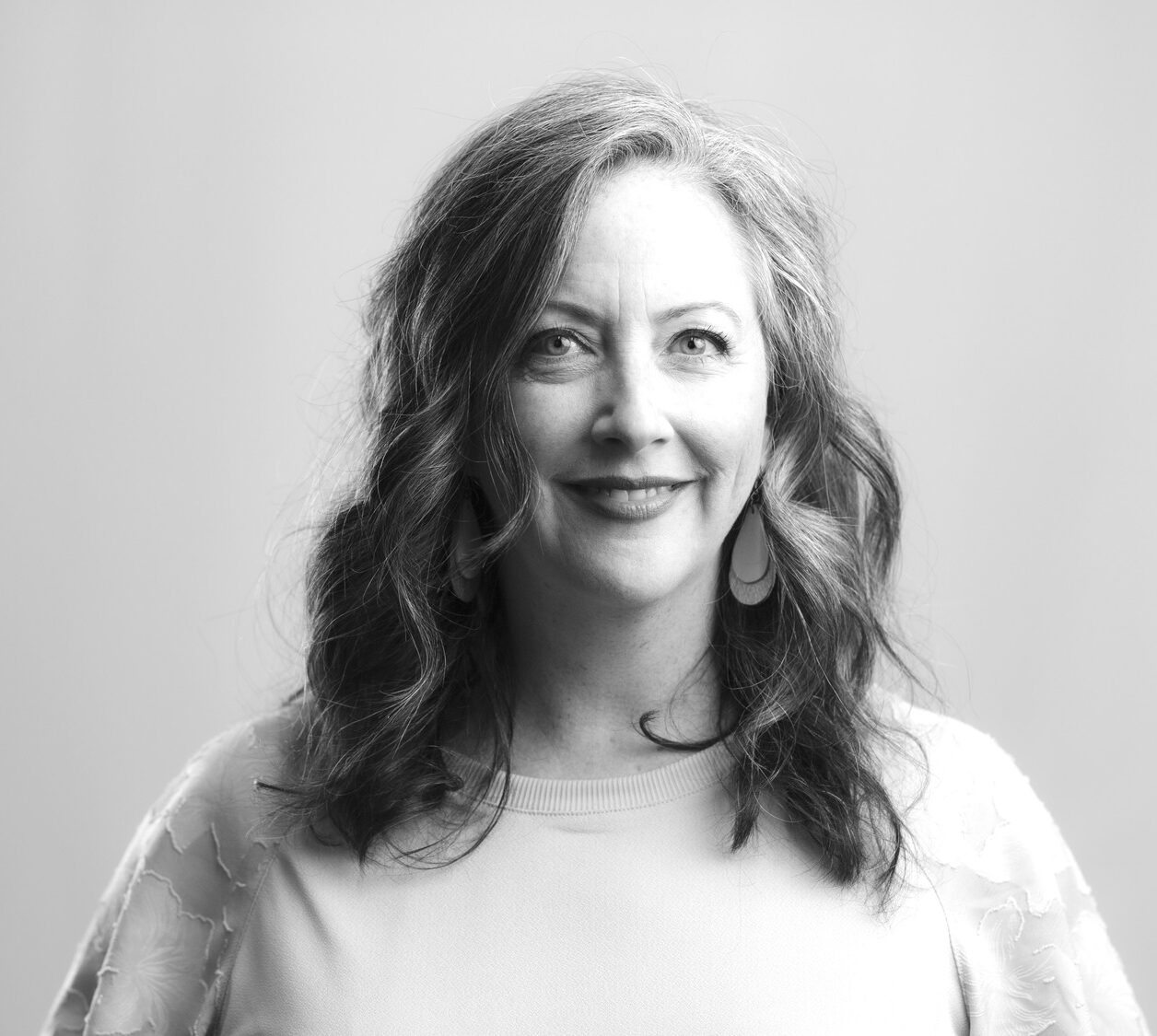
Alissa Brandt, Interior Designer, VP of Interiors
Q: What do you like best about designing student housing?
A: This particular market is always evolving based on what is happening in the world and how these influences affect them personally. The research is fascinating; students’ wants and needs are highly reflective of the current economic trends, environmental challenges, and social justice structure of their communities. They are pushing back on the status quo and are committed to making a difference for themselves and for others. They demand sustainability, are financially savvy and want real authentic design, not products that mimic the real thing and they are so open–minded and fluid.
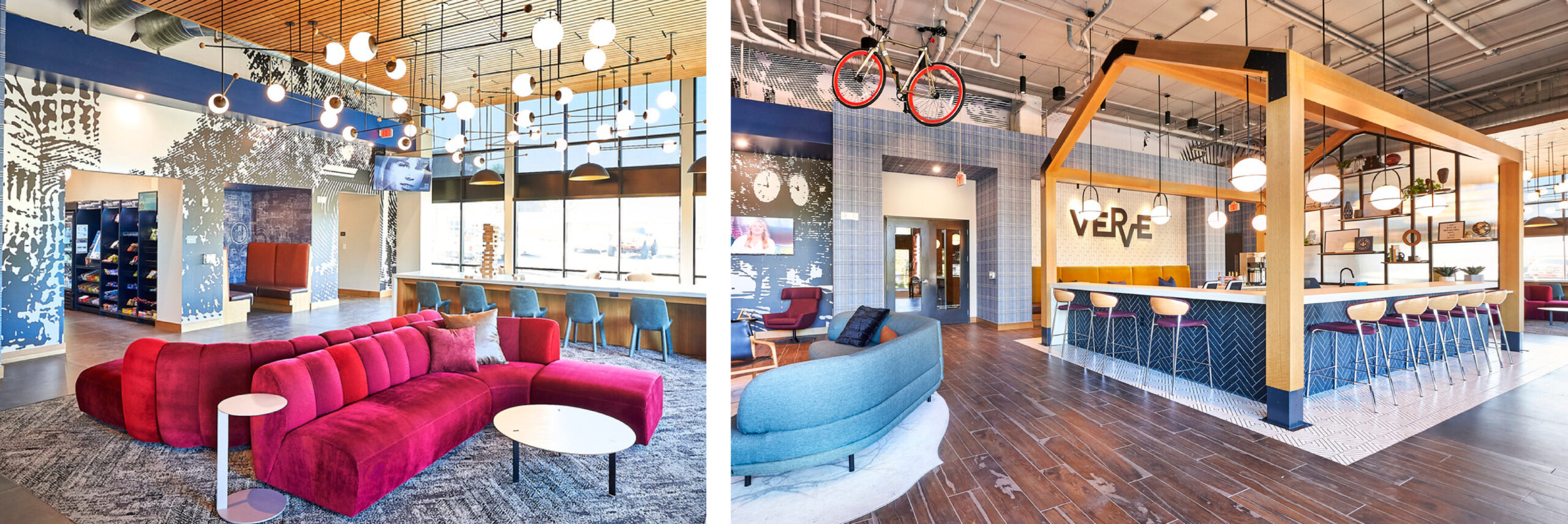
Verve Bloomington
Q: What’s something that has you excited about future work in this sector? What trends are you seeing?
A: Design remains on the cusp of what is next. Gen Z doesn’t want what everyone else has, they want what comes next. They are clever and creative and so multi-experiential.Designing for Gen Z requires you to consider all of the possible ways different people may do the same thing and tailor a design to allow each person to embrace spaces as their own. It is about creating opportunities for connection, engaged active behavior, solo thoughtful work, and everything in between for EACH person. One size does not fit all, and their lifestyles require flexibility be built into their environment. Wellness is a major consideration in designing for Gen Z. This generation prioritizes the need to take care of themselves, they crave access to nature, and they think about their health holistically not just physical wellness, but emotional, spiritual, and psychological well-being are all equally important.
Q: What’s uniquely challenging about designing student housing?
A: The obvious answer is timing. Everything revolves around the opening date. You simply don’t have any flexibly in delivering this product as students have signed contracts and school is starting, but that is more logistics and process.
The more interesting challenges are understanding what students wants are specific to the University location. What drew them to this particular college/university? You have to dig in, research, and understand the regional and local context in order to find ways to celebrate those, while also being mindful to not over commit to this as a concept as not everyone finds the same idea appealing.
The other fun challenge is staying relevant and up to date on trends, what does the demographic want and expect right now? And even more important, anticipating how these desires will morph over the next 2-3 years while the project is in design and construction. There is a delicate balance between being trendy and being relevant. That is the job of the designer to decipher and implement and anticipate the future needs and wants of the residents.
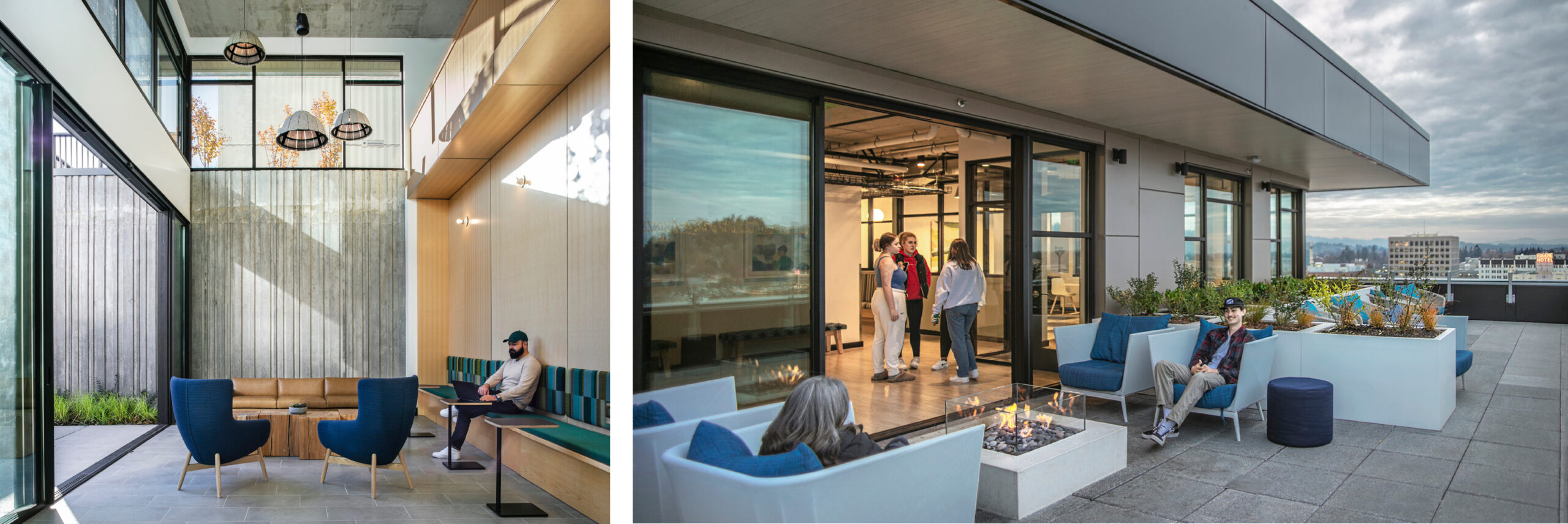
Union on Broadway
Q: What inspires you?
A: Creating spaces where students begin the next phase of their life. This is the first time many are away from home, family and friends and there is uncertainty but there is also tremendous excitement around what the future might bring and what opportunities they will find. Many will have experiences that they look back on for many years. This time in their lives shapes who they become. They develop lifelong friendships and find their own voice. It is really important to me that the design we provide elevates the experience these students have. Connection to the community, the university and to each other are so important to having a successful experience and we, as designers, have the opportunity to design these opportunities into these buildings. We research trends, demographics and psychographics so that we can provide spaces that are experiential, flexible and adaptable to the ever-changing needs of the residents. We get to consider all the types of people and personalities that will use the space and work to create design solutions that appeal to everyone. We always aim to create spaces that evoke emotion and feeling while also making them feel safe and secure.
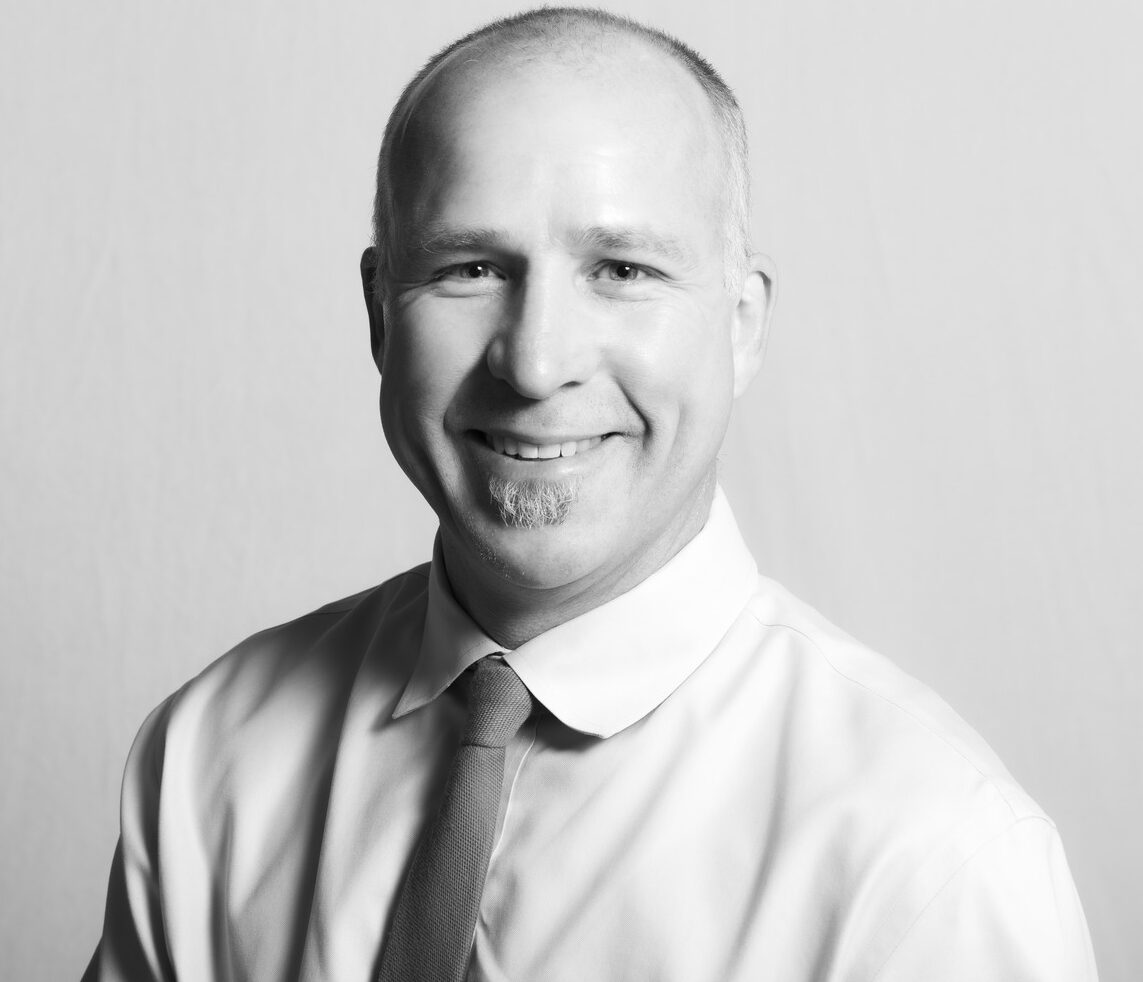
Matt Janssen, Architect, Design Principal
Q: What do you like best about designing student housing?
A: Designing a building which becomes “home” for someone leaving their family for the first time, or living in their own apartment for the first time off campus, while they pursue an education which will change their life forever, is invigorating. It is exciting to imagine the effect a place or space you design will have on student success and on an overall campus community.
Q: What’s something that has you excited about future work in this sector? What trends are you seeing?
A: There are two areas which I am very excited about right now: the effect design can have on student wellness, both mental and physical, and the ability for design, and the design process, to open up and create an environment of community inclusion and a sense of belonging wherein all are heard, all are seen, and all are appreciated for who they are and what they bring to the table. The developments in green technologies, including mass timber systems and the inclusion of biophilia in student housing, is exciting especially when thinking about student wellness.
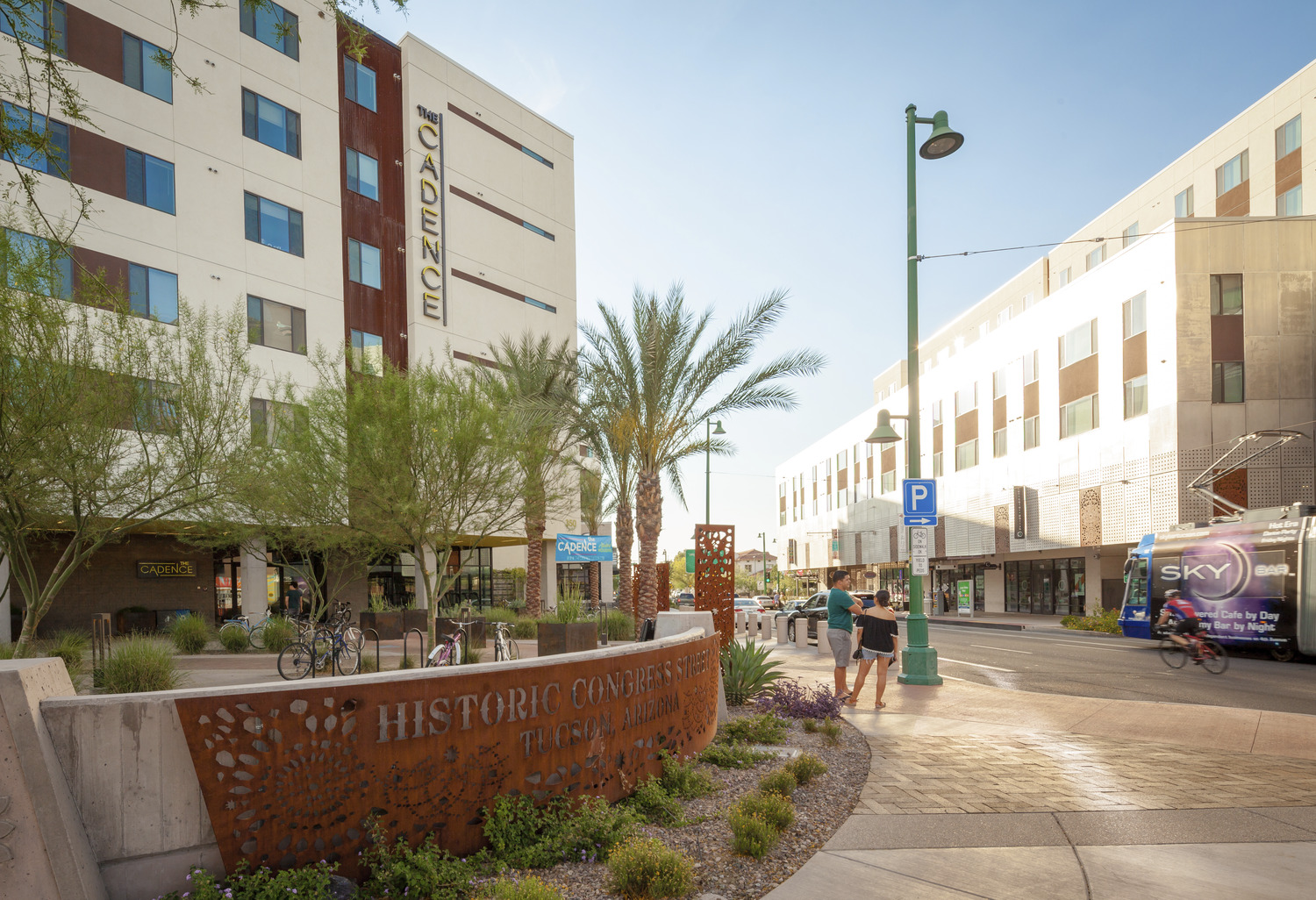
Cadence
Q: What’s a memorable moment from your career?
A: When the Cadence first opened, seeing the two buildings greet us coming into downtown Tucson surrounded by the new streetcar, bikes, and pedestrian activity, it was exciting to see the realization of everyone’s hard work to bring this vibrant, mixed-use, urban experience to this gateway location. That being said, the opportunity for my daughter to move into The Standard at Seattle this upcoming fall is going to be quite memorable. Having her live in a building I designed is both exciting and nerve-wracking.
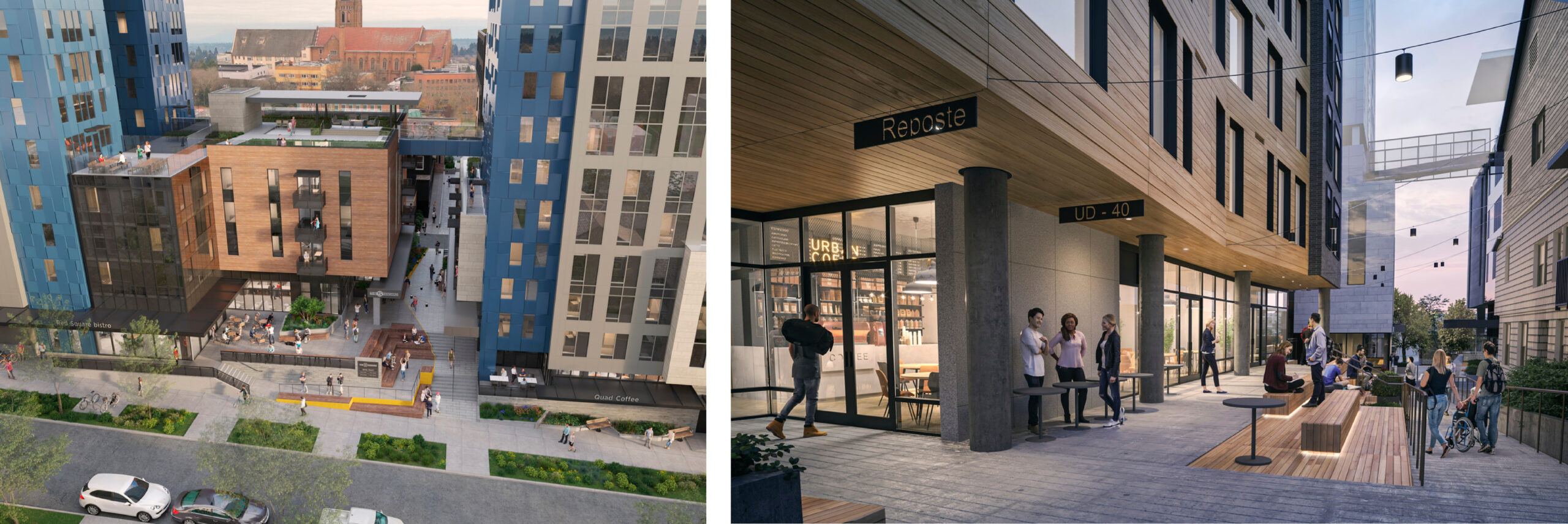
The Standard at Seattle
Q: What’s uniquely challenging about designing student housing?
A: Universities run on an annual schedule which does not change. As a result, projects must open on time and ready to go, typically by fall term. This creates an environment wherein decisions must be made quickly and efficiently. Being able to pivot, strategize, and problem solve when change happens is invigorating. Communicating with multiple stakeholders to understand everyone’s point of view, what their needs are, and how we can symbiotically mesh the various uses (residential, learning, offices, amenities, …) into a singular, holistic design which helps support student success is as rewarding as architecture gets for me.
Q: What interesting changes have you seen in this sector over the years?
A: It is exciting to see conversations of community and pedestrian activity be more of a topic of discussion rather than automobile parking. More and more, the design of alternative means of transportation in and around campuses, and how student housing ties into and supports those systems, will be critical now and in the coming years.
Vi Hilbert Hall at Seattle University
Want to get to know more of the Student Housing Team? Learn about Jason Jones and Cindy Schaumberg here.
An Interactive Timeline of Ankrom Moisan’s History
In celebration of Ankrom Moisan’s 40th anniversary this year, we look back and reflect upon the firm’s explosive growth, gathering the most significant and noteworthy projects and moments from AM’s history and culture. The result of all our hard work of digging, interviewing, and assembling information is an immersive, interactive timeline of milestones.
Take a walk down memory lane, reminisce, and celebrate 40 incredible years of Ankrom Moisan exploring beyond the expected. For the best experience, use Google Chrome on a desktop computer to view the timeline. If trouble scrolling is experienced, use arrow keys to navigate the milestones.


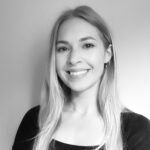
Graphic Design by Filo Canseco.
Research and Copy by Jack Cochran and Mackenzie Gilstrap.
How Architects are using Artificial Intelligence in the Design Process
Revolutions in digital tools and technology are rapidly changing the landscape of many different industries across the globe. One of the latest innovations in digital technology is the widespread use of Artificial Intelligence, or AI. Two Ankrom Moisan architects, Michael Great and Ramin Rezvani – Director of Design Strategy and Senior Project Designer, respectively – have recently begun to incorporate AI software into their design process, receiving encouraging results.
Before the advent of Artificial Intelligence software, precedent images sourced from Pinterest or similar could be used to establish the initial aesthetic direction of a project. Because not every feature of an image would be relevant for a certain project, these images were often cropped and/or collaged together, leading to unnecessary confusion if clients became attached to specific features in precedent images that were never intended to be a part of the final design. AI-generated images have the potential to circumvent that issue, providing inspiration imagery that is specific to a particular place, project, client and design.
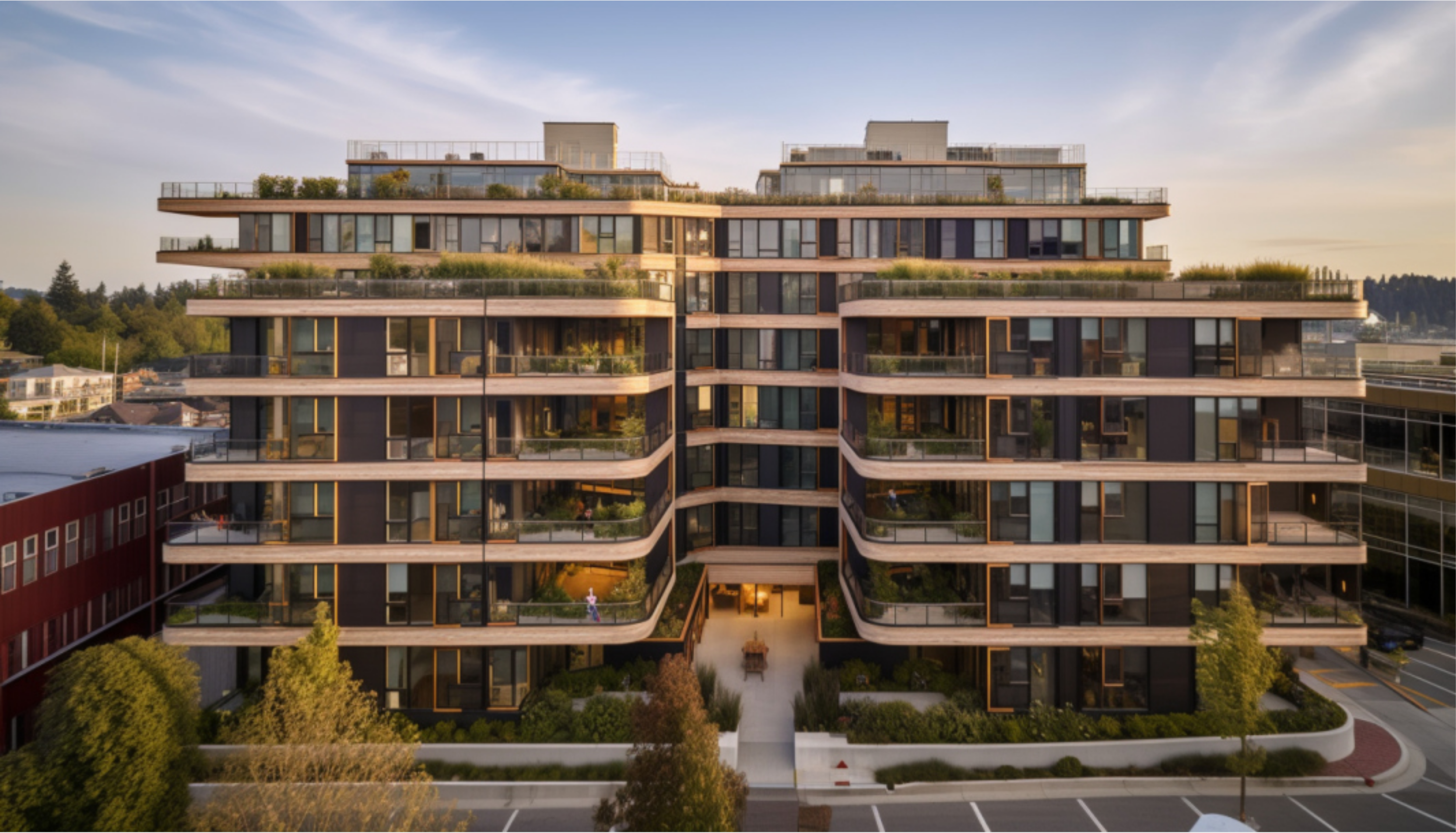
Example of an AI-generated precedent image.
Recently, Michael and Ramin have been using AI to create precedent imagery for their projects. In their experience, renderings created by AI software such as Midjourney assist in streamlining the design process and ensuring that clients are on the same page as designers when it comes to project design and direction.
For many, Artificial Intelligence still represents an enigmatic, complicated technology of the future, reserved for the plots of science fiction movies. However, recent developments in technology have made AI and its uses more widespread and accessible than ever. To explain how AI can be utilized to generate unique outcomes and facilitate a cohesive design language for a project, Michael and Ramin sat down to answer some questions about how Midjourney is integrated into the projects they work on and to dispel common misconceptions about the technology.

Michael and Ramin together in the Portland office.
Q: When did you begin incorporating AI into your approach to project design? Why was this something you decided to do?
Michael:
Our adoption of AI software has aligned with the technology’s continual improvement. Initially when we started experimenting with architectural imagery, it was giving us broad stroke building concept imagery. These were by no means a “design” but it got Ramin and I thinking, ‘Oh, this technology might be evolving to a place where we could utilize it more in the design process, let’s trial this a bit and see what we can get out of it.’
Part of my interest there is that historically architects have used precedent imagery to describe things that don’t exist yet, or to get clients aligned to what the design intent might be? Language doesn’t often get us to a full understanding. So, I think architects have always used imagery, whether that’s precedent imagery or rough sketches to just get alignment about the direction of a project aesthetically. Both Ramin and I have always thought it was strange that in this process you are often using existing buildings to convey new ideas. I think the advantage of using Midjourney and AI is that we can accomplish the same general task of conceptual alignment but show clients unique imagery that is specific to their project, place and aesthetic.
Ramin:
We just started playing around with Midjourney when it came out. It was really exciting and interesting, and we had no idea what it was, or what it could do, or how powerful it was the first couple of times we were testing it out. Then we tried to make it do something specific, and that’s where it started getting fascinating, because it’s potentially a huge shortcut for certain things- especially with generating concept imagery.
We kind of hit a wall with a project where we wanted to be able to quickly visually convey something that didn’t exist. We had some loose ideas influenced by some projects that only exist at a completely different scale than what we were looking at. We thought ‘let’s see if we can figure out how to combine all of these ideas and generate imagery to illustrate to the client where we are going with this.’ Through that process, getting imagery close to what we were trying to do was mind-blowing.
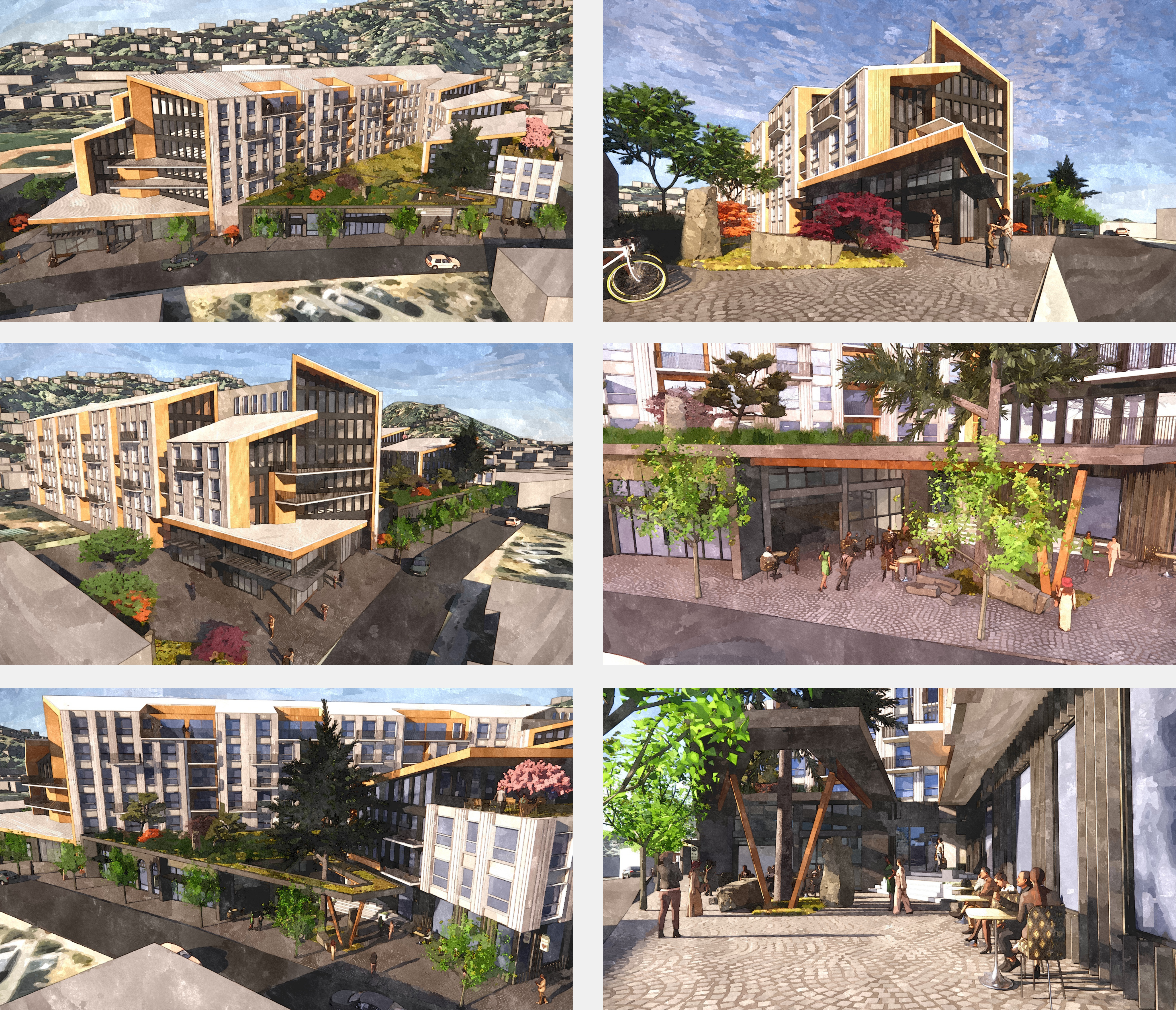
Final project design renders created by Michael and Ramin that were influenced by AI imagery.
Q: Ramin, you’ve said that AI is “like a paintbrush or any creative tool, you just need to figure out how to use it,” and Michael, that “it’s a language. You have to learn it, just like any software.” How did you both go about learning to use these tools, and how long did it take you to learn the language, so-to-speak?
Michael:
I don’t know how far we actually are on that journey, and I think we have a long way to go. There are a ton of resources out there, though, in terms of helping you learn the language through prompt editing. But this is moving so fast that there is now software that will do your prompts for you. You can just add in a few descriptive words, and it’ll fill in the rest, writing it in the way that the AI software wants to see it. Every time you use it, the more you use it, you learn something about what the output is. The more trial and error you go through, the faster you get at getting to an image you can use.
You have to think differently about the words you are using to get the imagery desired. It’s a shift in how you think since you have to use fewer words to get your idea across. You must be specific and pointed while still giving the software enough information. From that standpoint, I feel like the faster you can get your mind into that mode of thinking, the better off you will be as AI continues to develop, because the premise of utilizing language to direct output will only accelerate from here.
What we all have to adapt to and learn is how to use language to describe what we want machines to do. But even that is probably a couple years from being obsolete. There seems to be an updated version of Midjourney every month that’s substantially better than the last. Even since we last talked, they’ve come out with reverse-prompt capability. So instead of putting a text prompt and getting an image, you can do the opposite, dropping in an image and getting a prompt. By doing so you can start to understand the language in reverse because you’re dropping in an image and the AI is telling you what it sees in text.
Ramin:
I’ve been using it a lot, trying to figure out how to create very specific imagery. Like Michael said, it’s a lot of trial and error. To be able to get usable images, it has definitely required a shift in the way that I think due to the way that the prompts work. I’ve been approaching it almost like a science experiment, changing the prompts slightly with each iteration to see what I get back visually with each update. But also, it’s not like you can master it because it’s changing so rapidly. The next versions will likely have a completely different interface, so the way that you write prompts will likely change too.
Q: Can you walk me through the typical steps of using Midjourney to create precedent imagery?
Michael:
The process right now that we’ve been utilizing is that we’re trying to plug it in to an existing process. On a lot of our projects, we start by charette-ing and brainstorming, trying to develop a cohesive concept. AI software like Midjourney increases the speed at which we can reach solutions, because we’re not all going in different design directions.
What we’ve tried to do initially is take the guiding design principles for a project and feed those words into the AI to see what kind of visual representation it would create with our initial thoughts. So again, trying to accelerate the process a bit and get to visuals through words that we’ve already talked about or discussed to create alignment on design direction. As the technology evolves, there will be other ways for us to utilize it, maybe in final renderings, for instance. But right now, I think coming up with precedent imagery is the best use of it.
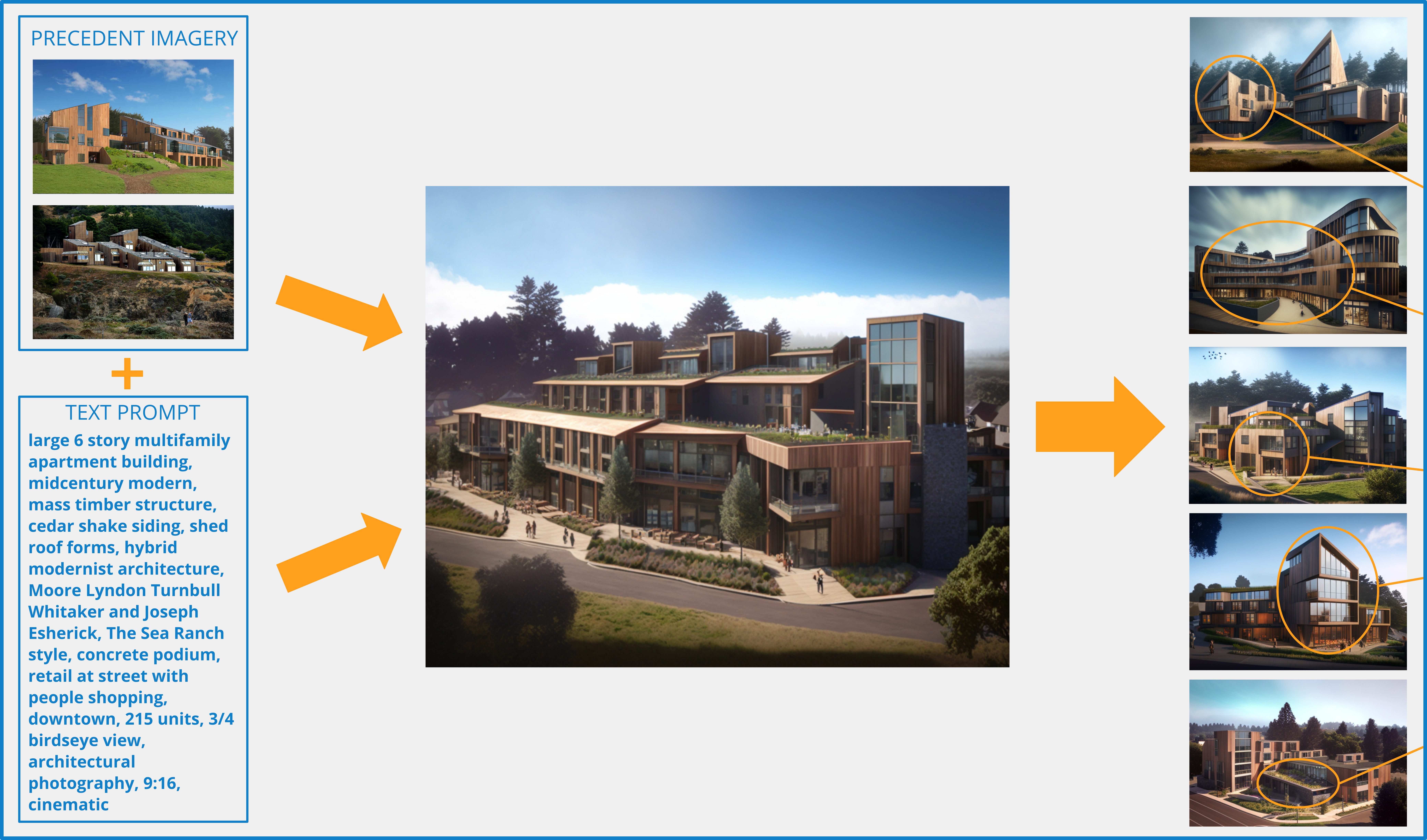
Visual breakdown of how guiding design principles and text prompts are used to generate new precedent imagery renderings with AI software.
Q: [You’ve] said that clients often don’t know what to make of design renderings when they learn that they were created by AI. What are some common misconceptions or misunderstandings about Artificial Intelligence that you’ve encountered since you began using it?
Michael:
The most common misconception that Ramin and I have run into is that the AI-created images are just precedent imagery pulled from the internet. You have to explain that it’s not a search engine, it’s not finding an existing image on the web. Often, I have to describe what it does in shorthand for people to understand it.
Ramin:
One of the things I noticed right away was people asking ‘doesn’t this take the creative process out of architecture now that you have this image designed by AI?’ At least for the time being, I don’t feel that way. As a design team, you still have to generate the foundational ideas and coax the AI to output something that aligns with your goals and vision. It’s a quick way to get the team on the same page and discover interesting emergent qualities from concept intersections that you may not have discovered on your own. In our current workflow AI produced visuals are intended to draw from and quickly study a whole bunch of different ideas to curate the most interesting aspects of each, based on what we asked the software to do.
Q: Do you have any fears surrounding the use of AI or the rate at which it is evolving, a la Terminator’s Skynet?
Michael:
Like any new technology, it absolutely has the ability to be used in various ways. I mean, there’s no way around that. I think there’s many applications of AI that could be negative, primarily in terms of its ability to manipulate people. But in terms of what we do, there’s not much risk if you understand it’s just one tool out of many that we can use. It’s not like Midjourney will actually produce architecture. It produces ideas that a designer still has to understand, edit, and synthesize into a project’s end design.
Ramin:
It’s hard to tell right now what is going to change and how much it will change. I’m definitely concerned about it, not just for the field of architecture, but for humans. In general, I feel like no technology has advanced this quickly before and it will continue to accelerate. There are just so many unknowns but I’m sure we will quickly see AI implementation in daily life. I think that we’ll know a lot more in the next five years or so.
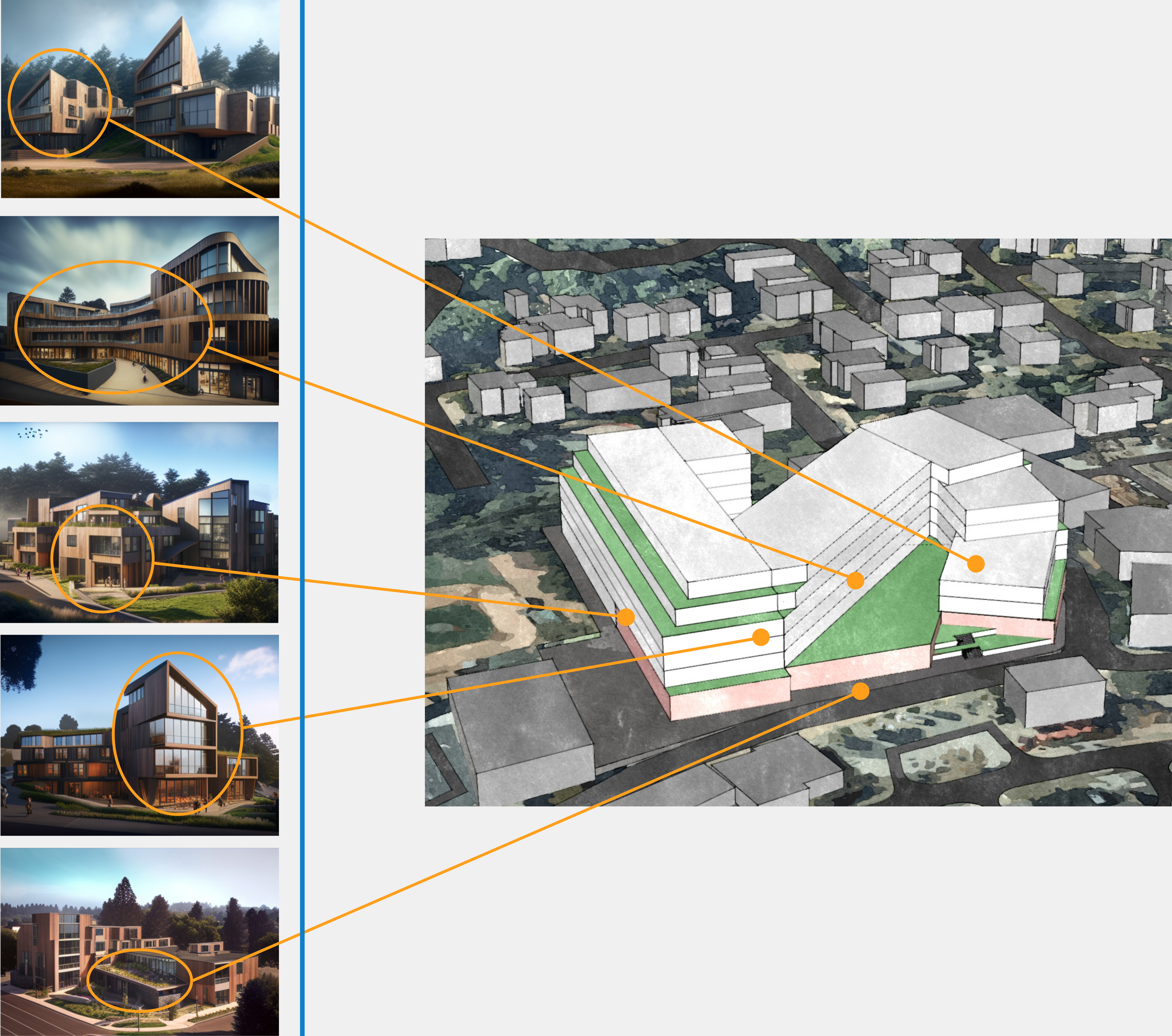
AI process design results, highlighting the Midjourney-generated concept renderings that Michael and Ramin synthesized and incorporated into the initial massing render for a project.
Q: With the rapid speed at which AI changes and evolves, how do you envision the future of AI as it relates to architecture? What about the future of architecture as it relates to AI?
Michael:
I think that AI continues a theme that has remained consistent throughout the last 100 years in terms of how architecture utilizes technology. Usually, it’s used to speed up the design process. One thing about architecture that’s so different from a lot of other professions is that it still relies on artistry, but there’s always a ‘hurry-up’ type of attitude, we are often pushed to develop designs and drawings faster and faster because of project economics. So, we’re always looking for tools to speed up the process. In addition, architecture is a broad profession. There are people doing wildly different things in the profession their whole career, and I think that could get streamlined.
Outside of Midjourney, there’s a whole slew of AI implementations using other design and construction software that’s meant to speed up how fast we can produce a construction set with fewer people. I think inevitably, that’s where architecture has always gone. 100 years ago, it took 40 people in a room, drawing a set for a high-rise tower by hand. I think in the future, a 40-story tower can probably be designed and drawn by two people. Eventually, the industry will get to a point where one or two people can accomplish that same task in half the time it takes now.
I would say that right now, as designers, we are not spending enough time understanding the place, the people using the building, and the environment surrounding a project. We’re rushing through a lot of those elements to get projects built, so I think where you end up by incorporating AI into that process is more thoughtful buildings, because we don’t have to spend as much time crossing the T’s and dotting the I’s. We can actually think about the project and the building rather than drawing it, and to me, that’s pretty exciting. Architecture can’t do anything but get better through this process. I don’t think anything gets worse. It just gets better.
Ramin:
In my mind, there’s no doubt that any areas of inefficiency in the architectural process right now, some of which will be resolved using AI. It’s going to accelerate and amplify the amount that an individual can do by themselves, so I think it’ll take fewer people to do the same amount of work.
I think it will allow us to study way more aspects of a project quickly and, like Michael said, make projects significantly better by understanding more of the site’s parameters. It feels like an amplification to me now, but who knows what will happen in six months?
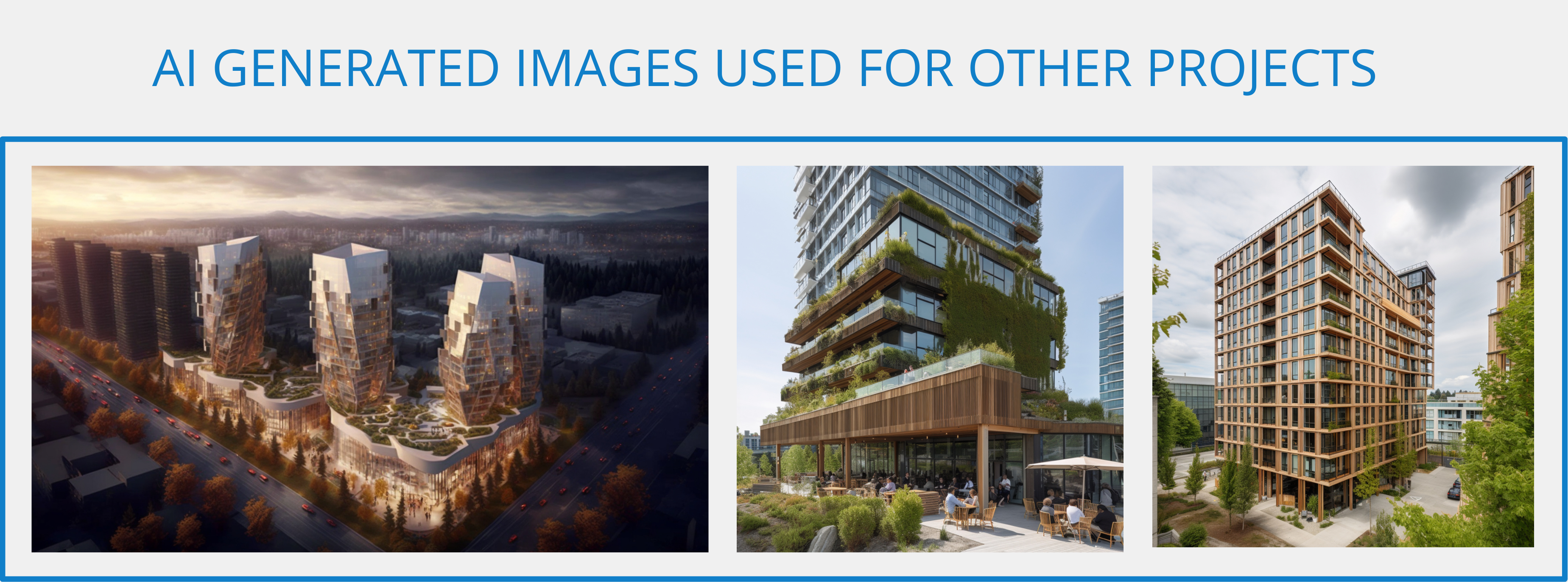
AI-rendered precedent imagery from other projects.
Compared to other Pacific Northwest architecture firms, Ankrom Moisan is a pacesetter in terms of integrating Artificial Intelligence and other digital tools. Few competitors use AI, if at all. International firms, though, tend to use AI software for design-based research. However you cut it, the digital tools of imagined sci-fi futures are closer than it seems, and may, in fact, already be here. It’s a massive paradigm shift that will take some time to get used to, but the good news is that when the AI overlords take over, we will already know how to deal with them.

By Jack Cochran, Marketing Coordinator
Dignified Healing Spaces
Does design have the power to enhance dignity?
Many of us have the privilege to go about our daily lives unaware of the powerful role the built environment plays in supporting our feeling of being celebrated and respected. As architects and designers, we must place inhabitants’ dignity at the forefront of our design priorities. Our work has the power to create spaces that have far reaching and lasting impacts. Few places need this perspective more than spaces that serve predominantly underserved, underrepresented, or socially stigmatized communities.
To start, what is dignity?
Dignity is the right of a person to be treated ethically as well as being valued and respected for who they are. For healthcare professionals dignified care means recognizing and honoring patients’ capacities and ambitions. While patient dignity is a core tenant of healthcare staff training, it is also critically important to consider the role of the built environment to support dignity for both patients and staff.
Dignity can be defined by four main factors:
- Respect – Respect includes self-respect, respect for others, respect for peoples’ privacy, and confidentiality.
- Autonomy – Autonomy includes having choices, being able to make decisions, rights, needs, and independence.
- Empowerment – Empowerment includes feelings of being important and valuable, self-esteem or self-worth, and pride.
- Communication – Communication includes clear information, language, intuitive wayfinding and directional cues, and privacy.
Here are five considerations for designing dignified environments:
Design as a Beacon
Too often, mental health and treatment program facilities exist in hidden spaces kept out of sight from the public. We aim to create spaces which bring a sense of pride to those who enter. By considering each step of the end-user experience, from the street approach to the quality of finishes, we aim to thoughtfully apply design aesthetics to create a welcoming facility from the very earliest interactions. Welcoming patients, clinicians, and the community into a space that is beautifully designed to support the specific needs and identity of the users is a meaningful way to communicate the intrinsic value of the patients and clients within those spaces.
In initial design discussions, Compass Health requested a sense of grandeur within their new facility located in Everett, Washington. After years of making do with an aging building, the goal for their Phase II building, housing both inpatient and outpatient behavioral healthcare, was to create a space that anyone would feel proud to enter. The stigma of mental health treatment was stripped away by prioritizing a grand, double-height entry and foyer that highlights exterior garden space. The exterior finishes were selected to be warm and welcoming.
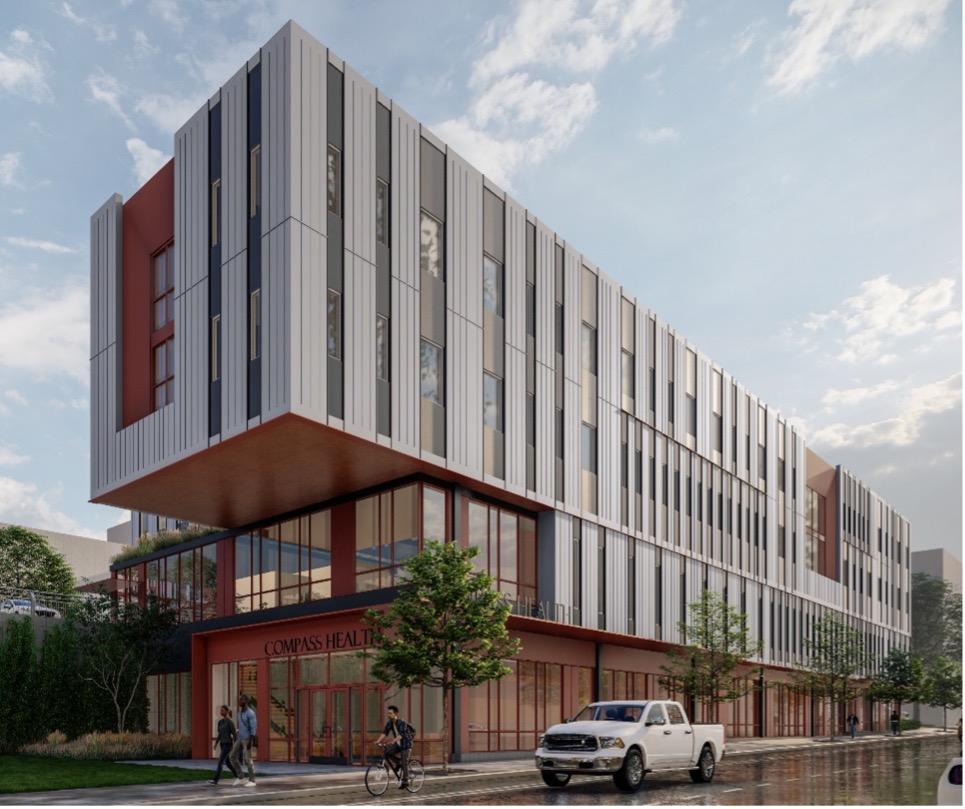
Compass Health’s Phase II: The entry design uses scale, richly colored materials, and nature to evoke a warm welcome to all who enter.
The Power of Choice
In design, when we do not acknowledge the vast spectrum of human needs, we strip away the ability to exercise autonomy and control over our surroundings. Design that is mindful of autonomy, considers a variety of mental states, capabilities, traumas, and preferences to create dynamic spaces which allow people to choose the experience that fits their needs best in that moment. Avoiding the stress of being in an uncomfortable space allows patients and clients to receive care while in the best possible mindset. It also reduces negative associations that may become barriers for seeking care in the future. In many cases, mental health, housing, or medical facilities unintentionally strip away the opportunities for personal choice due to logistics and procedures, but thoughtful communication with providers allows designers to construct opportunities for choice and autonomy within even the highest acuity patient types.
The design team on the Alameda Senior Respite and Primary Care Facility acknowledged the importance of choice and autonomy in the design of the new 30,000 sq. ft. facility serving Alameda County in California. The design, which creates permanent supportive housing for an aging subset of the local homeless population, thoughtfully addresses the need for individual choice by completely rethinking the approach to lighting design throughout the building. Acknowledging the impact of harsh or bright lighting, uncomfortable lighting when resting, or a lack of lighting when trying to read and relax, the design team prioritized indirect lighting throughout all patient spaces, designed hallways outside of bedrooms to dim to the lowest levels allowed by code during quiet hours, and coordinated a wall sconce with controls at each bedside for residents. These simple, yet impactful, solutions allow residents to have autonomy over their surroundings in a way many of us would take for granted.
Safety over Security
We deserve to feel safe in our environments, and increasingly, facilities are moving towards providing a friendly face at entry points to help visitors feel welcome in lieu of uniformed security, which can be particularly traumatizing for many populations. Through collaboration with staff and clinicians, we can facilitate safety by designing clear pathways of visibility for observation and engagement that does not feel intrusive. Doing so allows visitors and residents to maintain their sense of independence and autonomy while remaining safe. Intentionally designed spaces which focus on relationship building increase the safety of patients while also increasing the likelihood of positive experiences and returns for subsequent care in the future.
The inpatient floors for Compass Health were laid out around a central nurse station allowing care teams to maintain a direct line of sight to all patient spaces, including the outdoor patient areas. Whereas other facilities require patients to be accompanied by a staff member to outdoor or group spaces, the clear paths of visibility allow patients to move from space to space unaccompanied, fostering independence while ensuring staff are aware of any interactions which may require their attention. Similarly, opportunities for passive observation in outpatient areas allow for easy circulation and a friendly face at various reception desks to assist first-time visitors and clients, as well as to foster connection with staff in various areas throughout the lobbies.
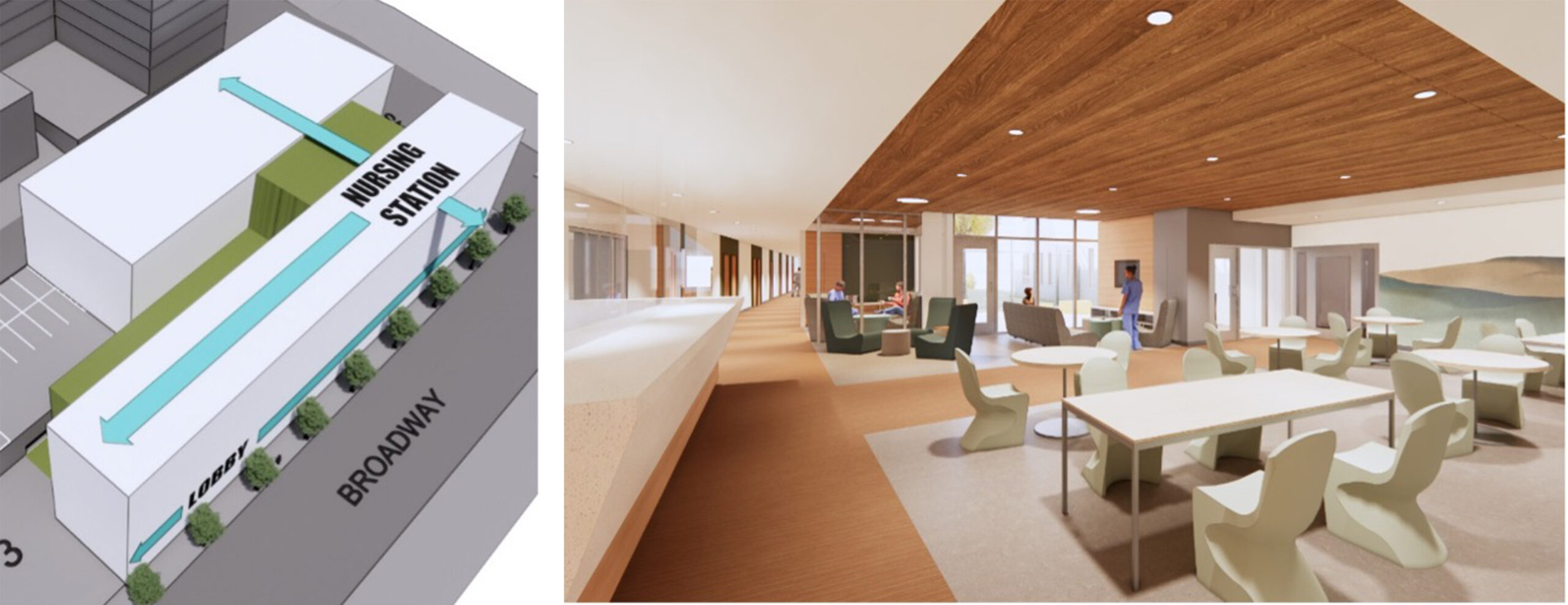
Compass Health Phase II: The building massing prioritized sightlines for the on-unit nursing and care team from the earliest diagrams (left). Interior design focused on maintaining the connection between staff and patients (right).
Whole Person Healing
If we consider the physical, mental, emotional, and social determinates of health in the design and programming process, we can create transformational facilities that help bolster the entire community. By creating space for additional programs and prominently locating basic needs near entries, each visitor can easily access support. Furthermore, designing medical care with counseling and housing opportunities provides a holistic approach to wellness that caters to a vast spectrum of needs, removing the barriers of care that occur when visiting many different facilities for the same services. Integrating community spaces into our designs allows additional social needs to be met that may not be related to specific medical needs, while inviting the community into spaces shared by diverse populations humanizes the experience of those seeking treatment in those spaces.
The core tenant of Central City Concern’s Blackburn Center is to “help people’s health through comfort, community, and safety.” The center, which serves people experiencing homelessness, poverty, and addiction in the Portland, Oregon area also aims to create a supportive housing project which incorporates mental and physical health resources under the same roof. The design carefully integrates a complex series of support systems that begin on the ground floor with commons area, teaching kitchen, pharmacy, and community services. Moving up a floor, the medical clinic supports the housing residents onsite. Housing includes palliative care, two floors of single room occupancy housing, and a floor of apartments for permanent housing, which supports people nearly ready to live on their own. The design aesthetics and function aim to create a fulfilling and enriching home-like experience that bolsters residents in all aspects of health and wellness, truly treating the whole person.
Nature as Medicine
Biophilia states that we, as humans, are part of nature and are inherently attracted to, and supported by, natural environments. Using nature as a tool to promote healing and wellness is a key part of providing users with the respect and dignity they deserve. Many at-risk populations receive care and housing in aging spaces that do not receive quality daylight, and access to outdoors is deemed too unsafe and difficult to monitor. By incorporating nature connections such as views, natural materials, fresh air, and plants into the requirements for healing spaces, we ultimately acknowledge the humanity of the occupants within a space. Whether they are patients, residents, visitors, or staff, everybody benefits from contact with nature through positive distractions, lowered blood pressure, increased resilience to environmental stressors, and the benefit of aligning our sense of time and place with the observable natural rhythms of the world around us.
Early on in Compass Health’s design process, the importance of fresh air and contact with nature was identified by the client and design team. As a result, the earliest building massing schemes explored how to bring nature as far into the building as possible. The resulting form for the inpatient floors is two separate wings positioned beside deeply cut rooftop gardens with a central connection space that serves as the primary gathering and dining area for the inpatient population. Each of the two floors of inpatient treatment have access to dedicated outdoor garden spaces that are designed to allow residents to move freely between interior living spaces and outdoor areas. Beyond the patient outdoor spaces are extensive green roofs which are visible from interior spaces in the public, staff, and patient spaces. This impactful design decision will support the healing and restorative vision of Compass Health’s mission to treat the whole person.
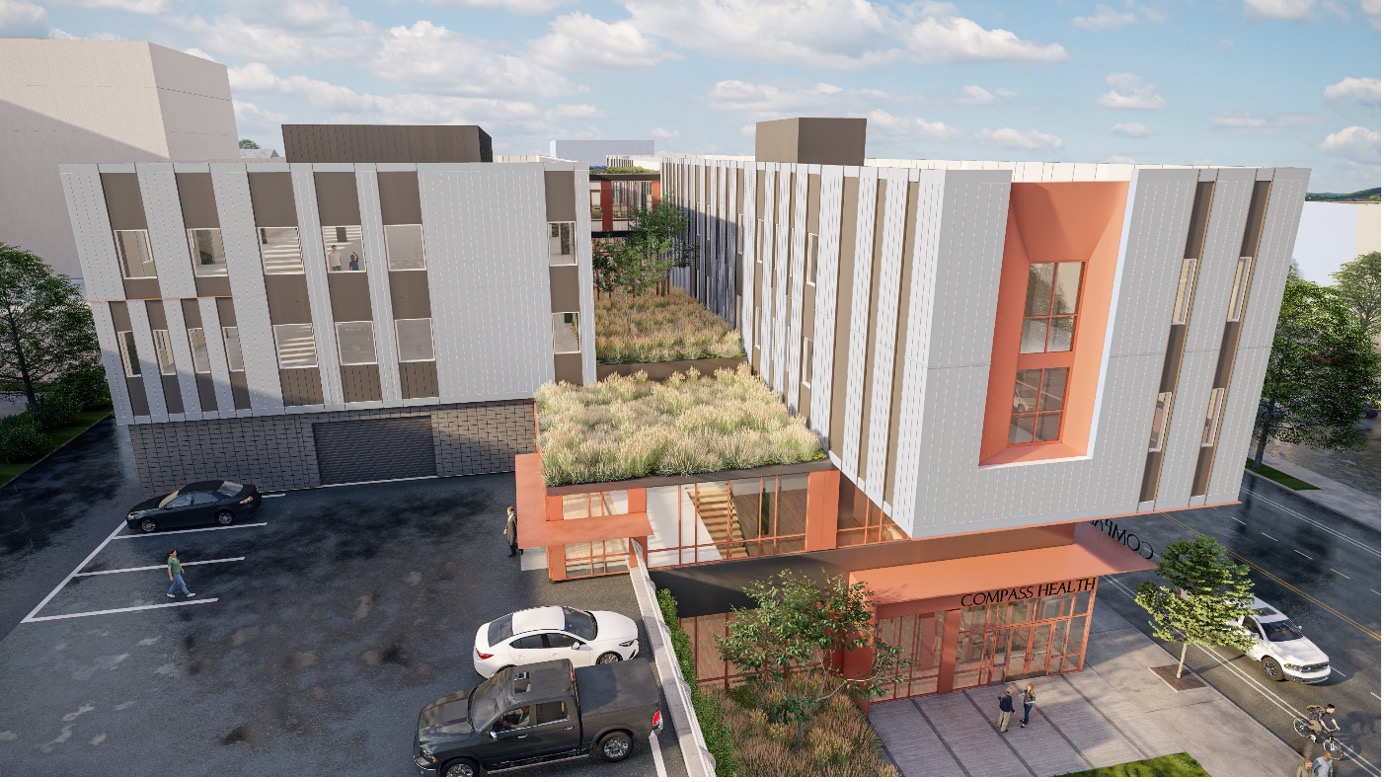
Compass Health Phase II: Both inpatient floors provide residents, staff, and visitors views of nature by utilizing the space between buildings for extensive green roofs.
Why design for dignity?
By implementing these five strategies, designers can create spaces that honor the core aspects of dignity by respecting each visitor and their unique place in the world, supporting their autonomy through choice, empower occupants as they move through the space, and ultimately communicate equitably inhabitants. The resulting designs are spaces which can be as meaningful as they are beautiful while actively participating in the health and growth of our communities.

By Ashlee Washington, Senior Associate
Indoor / Outdoor Air Quality
The Do GOOD / Be WELL scholarship encourages Ankrom Moisan employees to research an open-ended topic of their choosing and share the practical results of their findings with the firm, industry, and community at large. The scholarship, started in 2017, is sponsored in memory of former AM employee Carolyn Forsyth, an inspirational leader and unyielding force for change. Intended to honor her legacy of sustainability, equity, innovation, advocacy, education, and leadership, the DGBW scholarship elevates and empowers new and inspiring ideas within Ankrom Moisan and the broader field of architecture, pushing us all, as the name implies, to do good and be well.
As the recipient of the 2022 Do GOOD / Be WELL scholarship, Cara Godwin encouraged Ankrom Moisan employees to not only learn about air quality but to measure their own. Cara implemented a program that provided home air kits, consisting of a HEPA filter and an air sensor, to be checked out and taken home.
By using air sensors that provided a real-time air quality score, participants were able to better understand how opening windows, cooking, and running exhaust fans impact indoor air quality. The program also encouraged people to be Citizen Scientists by gathering data in their own respective environments and automatically sharing it to the Purple Air network map in real time, increasing the pool of scientific knowledge that design decisions can be made from.

Kaiterra Egg air sensor utilized in Cara’s research study.
The (Overlooked) Importance of Air Quality
Designers of the built environment are deeply familiar with energy scores and water scores, but air quality has been less defined and is often left unconsidered—Cara hopes to change that.
Cara has lived in the Methow Valley for twelve years now, an area which often deals with wildfire smoke. Cara and her husband had indoor air quality at the front of their minds when they built their home in 2011. Their son has had respiratory issues since birth and asthma since just before his second birthday, which led the pair to learn more about indoor and outdoor air quality. “We are a ‘Clean Air Methow Ambassador,’ we have been interviewed on a podcast, interviewed by a health reporter, and often my son’s photo and story are used in discussions about air quality,” Cara stated. “This scholarship seemed like a natural way to share this information with coworkers and hopefully have a positive impact on future building designs.”

The Godwins: Cara, her husband, and her son.
Even if you have not personally noticed issues with air quality, you are likely being affected by air pollutants. More and more research talks about PM2.5 – fine inhalable particles with diameters that are 2.5 micrometers or smaller – and their long-term effect on our lungs. PM2.5 sources include chemical exhaust from industries and automobiles, wildfire smoke, pollen, dust, and hundreds of other chemicals. EPA and other clean air groups are focusing on education for people to understand air scores and sources. This study helps expand those efforts.
The Findings from the Air Sensors
The most common response from kit recipients was about cooking. It is uncommon for range hoods to be used every time a cooktop is utilized, though that is the recommendation. After receiving their results, many participants noted they will use the hood more often. One participant noted that their charcoal recirculating exhaust fan was not adequate on its own and required a window to be open for proper ventilation.
Another finding was that pets do not seem to have a negative impact on air quality. Running the HEPA filter had noticeable positive impacts for participants with seasonal allergies and asthma.
In a survey filled out after using test kits at home for a few weeks, participants were asked what they might do differently in future designs after receiving their own personal air quality scores. Several responded by advocating for electric cooking over gas. A few mentioned advocating for operable windows and making operable windows open further. There is a desire to avoid using charcoal recirculating fans for kitchen exhaust. Others mentioned trying to design for air changes above code minimum and running the whole house exhaust longer.
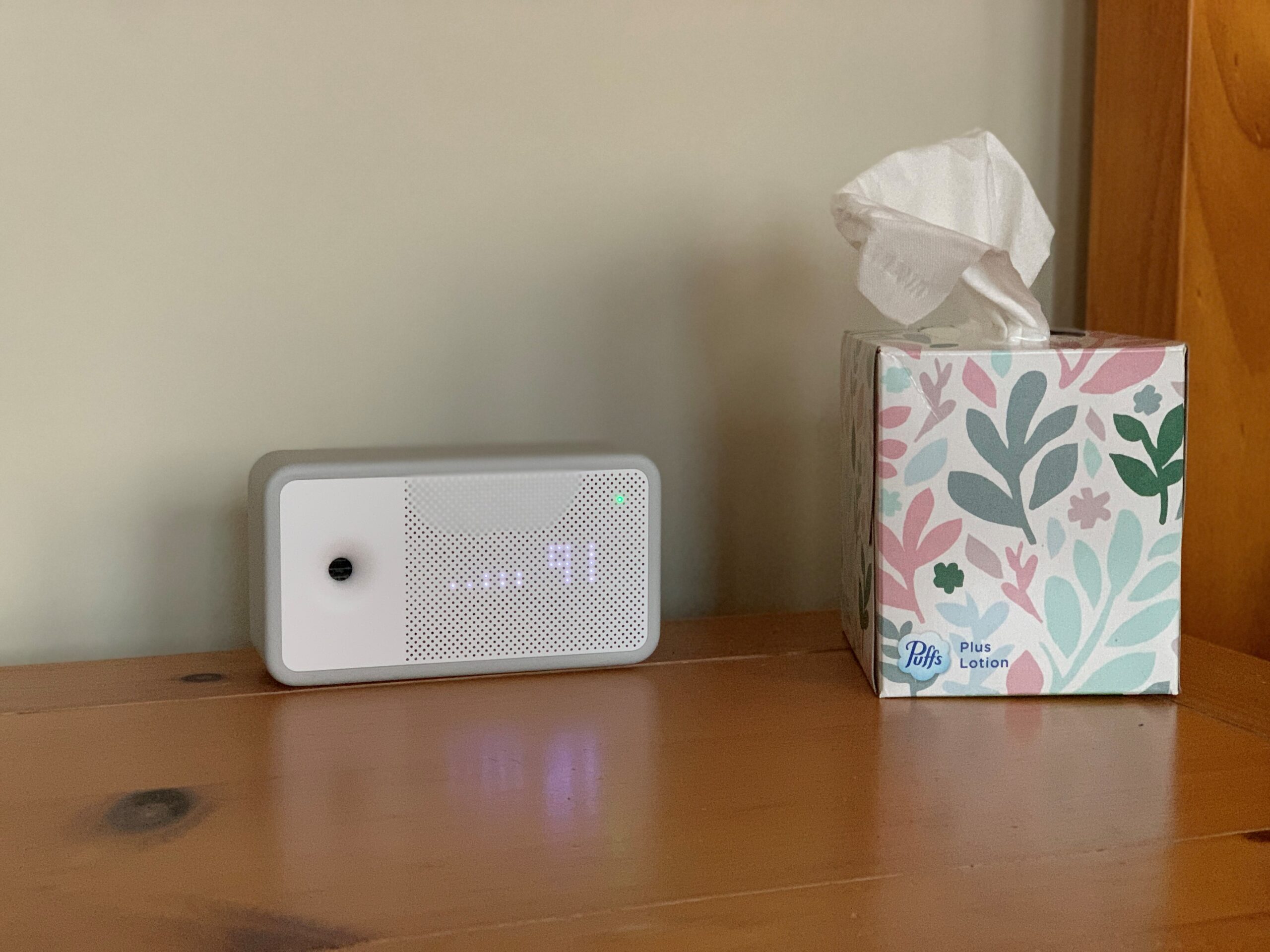
Awair air monitor in use.
Swapping Cooktops to Improve Air Quality
During this time, Cara was looking into replacing her propane cooktop with an electric induction range and took the opportunity to tie her search in with her research proposal, using the information gathered from the use of the HEPA filter and air sensor to guide her purchase decision, and sharing the results with the firm. This choice was supported by Cara’s experiences with indoor air quality monitors, as they have demonstrated that cooking has the greatest impact on air quality in a home. Cara swapped out her propane cooktop for a gas one, as well as her exhaust hood in hopes that a quieter exhaust hood would be used more. Finding the right induction range was the tricky part. The options seem limited, and costs vary greatly.
Her research found that the difference in cost is dependent on the size of the magnet, and that the size of the magnet, or burner, should match the size of the pan being used. This is because a pan too large for a burner will not heat up efficiently, and food will not be evenly cooked. The main obstacle in sourcing a new cooktop was related to finding black appliances, which have even fewer options. In the end, Cara switched to black stainless steel. For the exhaust hood, quieter options require an 8” exhaust duct. Cara’s pre-existing duct was only 6”, meaning it was not feasible to replace the exhaust duct in the roof assembly, so the new hood is only slightly better in terms of noise level.
For the actual experience with induction cooking, Cara states that “it has been a real pleasure to cook with. The cooking is more even, and water does boil as fast as everyone says. There is also peace of mind with all the recent news of harmful chemicals coming from gas cooktops.” The original concern with the propane cooktop had to do with CO2 levels rising during seasonal times of wildfire smoke when fresh air is closed off, but the benefits of an induction range have expanded to all year round. Cara recommends induction over gas to anyone building new construction, and in her case, with someone with respiratory issues in the house, switching is a great option.
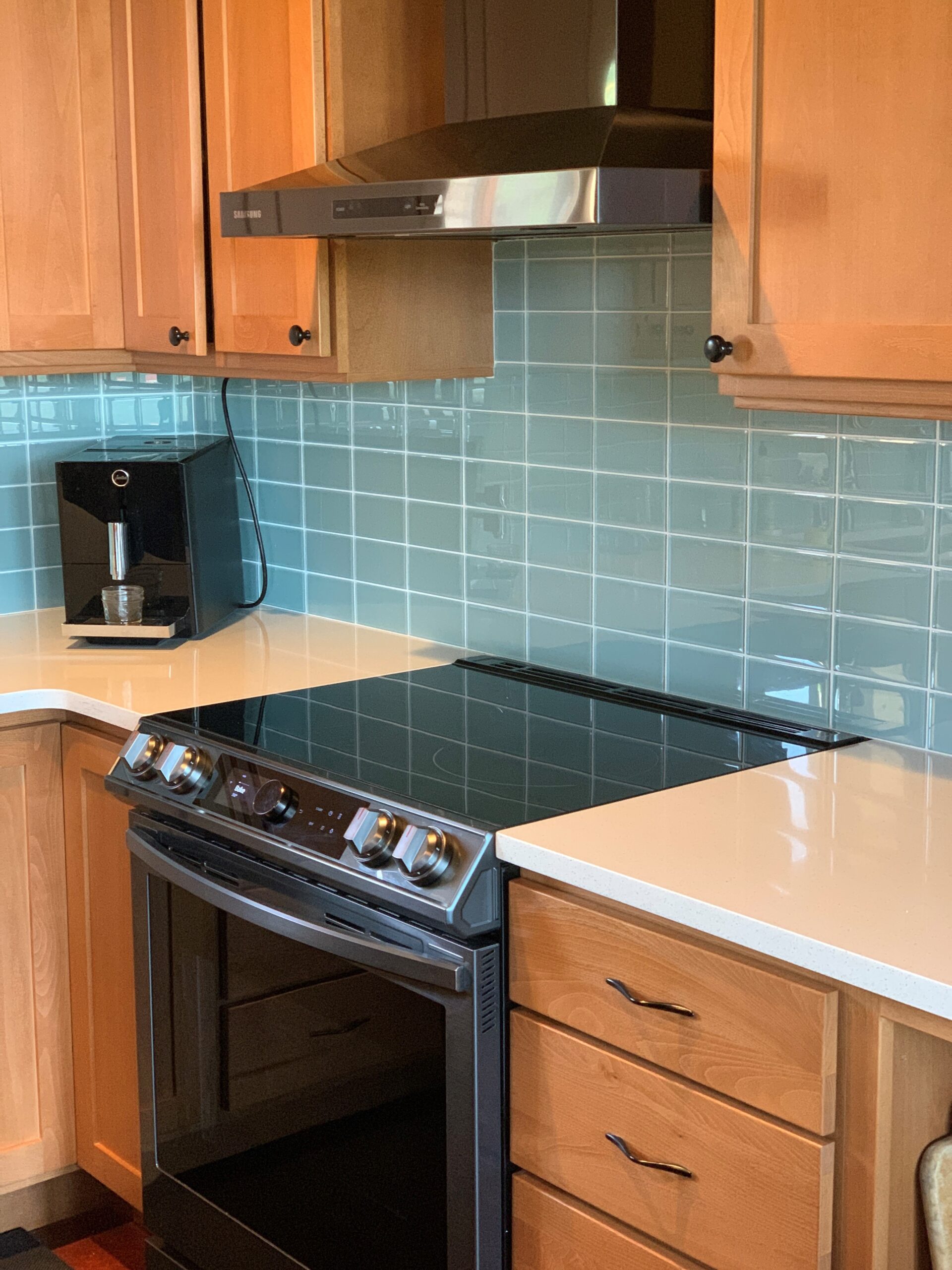
Cara’s new black stainless steel induction range with hood.
Applying the Research to our Designs
If you have not experienced it yourself, you probably know someone who has had to alter their plans or take medication due to allergies to pets, perfume, or wildfire smoke. At Ankrom Moisan, we talk about designing for all users and that should include designing for respiratory sensitivities.
This study will hopefully help influence future building designs to take user sensitivities into account, and therefore create buildings that are a haven from pollutants and irritants during times of poor outdoor air quality. And in times of good outdoor air quality, our spaces should reduce known contributors to poor indoor air quality.
One example of how we can design more inclusively is to consider air quality and pet allergies. Many residential communities today allow dogs but that can exclude people with allergies from living there—unless the air quality improves and the building, as well as furnishing, is designed to minimize pet dander. Our designers, armed with the findings from Cara’s research, can also advocate for features that will benefit everyone such as electric induction ranges, quieter exhaust hoods and operable kitchen windows
Though indoor and outdoor air quality is a consideration that is often forgotten, Cara’s DGBW research program illustrates the importance of bringing all aspects of wellness into a building’s design, and redefines how we explore beyond, changing what designing for inclusiveness can mean.

By Cara Godwin, Practice Manager
Employee Spotlight: May Au
It seems that May Au was destined to be an artist. Her sketches appear in the firm’s “AM is Sketchy” Teams channel to the delight of many, inspiring her coworkers to embrace their creative side and see things from a new perspective.
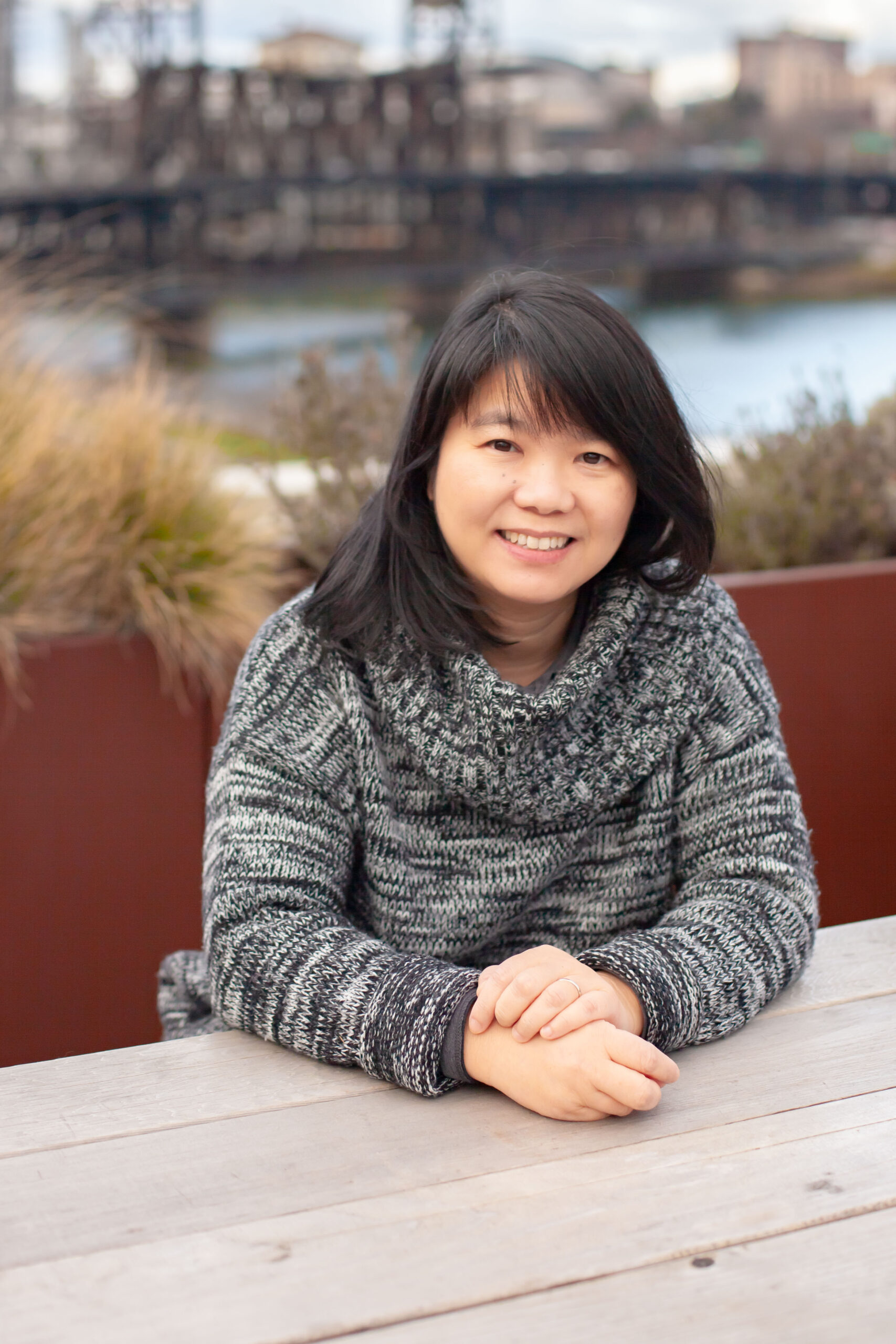
Architect and artist May Au poses atop Ankrom Moisan’s Portland office.
This began as a result of the recurring Thursday drawing classes, the products of which are shared on the AM is Sketchy channel. May received enthusiastic feedback from her colleagues, who wanted to know more about her process. “A couple of people were interested in learning how I draw,” May said. Roberta Pennington asked May if she would share her process with the firm, and although May was hesitant at first, she eventually agreed, but not before deciding to spruce up her presentation. “I thought it would be kind of boring if I just drew on live,” May explained. “I thought that during this precious lunch hour, people would probably want to draw more than watching me, so I thought ‘I should speed that up in Procreate and record the process.’” Even her management team took notice of May’s art; Ryan Miyahira asked May to share her sketching process at a team meeting. Luckily, she already had recordings of her sketching process from a trip she took to Nice, France. May paired her time lapse videos with narration and music recorded by her husband and Emily Bear, respectively. The videos were shared on the company’s Teams channels, catching the attention of many, and causing May to be nominated for an employee spotlight feature.
May was drawn (pardon the pun) to painting in kindergarten, when she took note of artwork hanging on the walls of her classroom and aspired to learn how to draw and paint when she grew up. Her older sister encouraged this newfound passion, singing May original songs such as “I’m a Little Painter,” which she particularly loved.
In college and at the beginning of her career as an architect, May attended live drawing sessions to draw models, and would often check out books on the sketches of her favorite artists – Michaelangelo, Da Vinci, and Rembrandt – from the school library when she was supposed to be studying. These habits strengthened her eye for detail, a trait which she would rely on in her work as an architect. She explained the connection between her sketches and architectural work, saying “in general, architects must detail projects out quite a bit. We need to be efficient, and we don’t want to do the work incorrectly, so you always have to check yourself and ask, ‘am I doing it in the right way?’.”
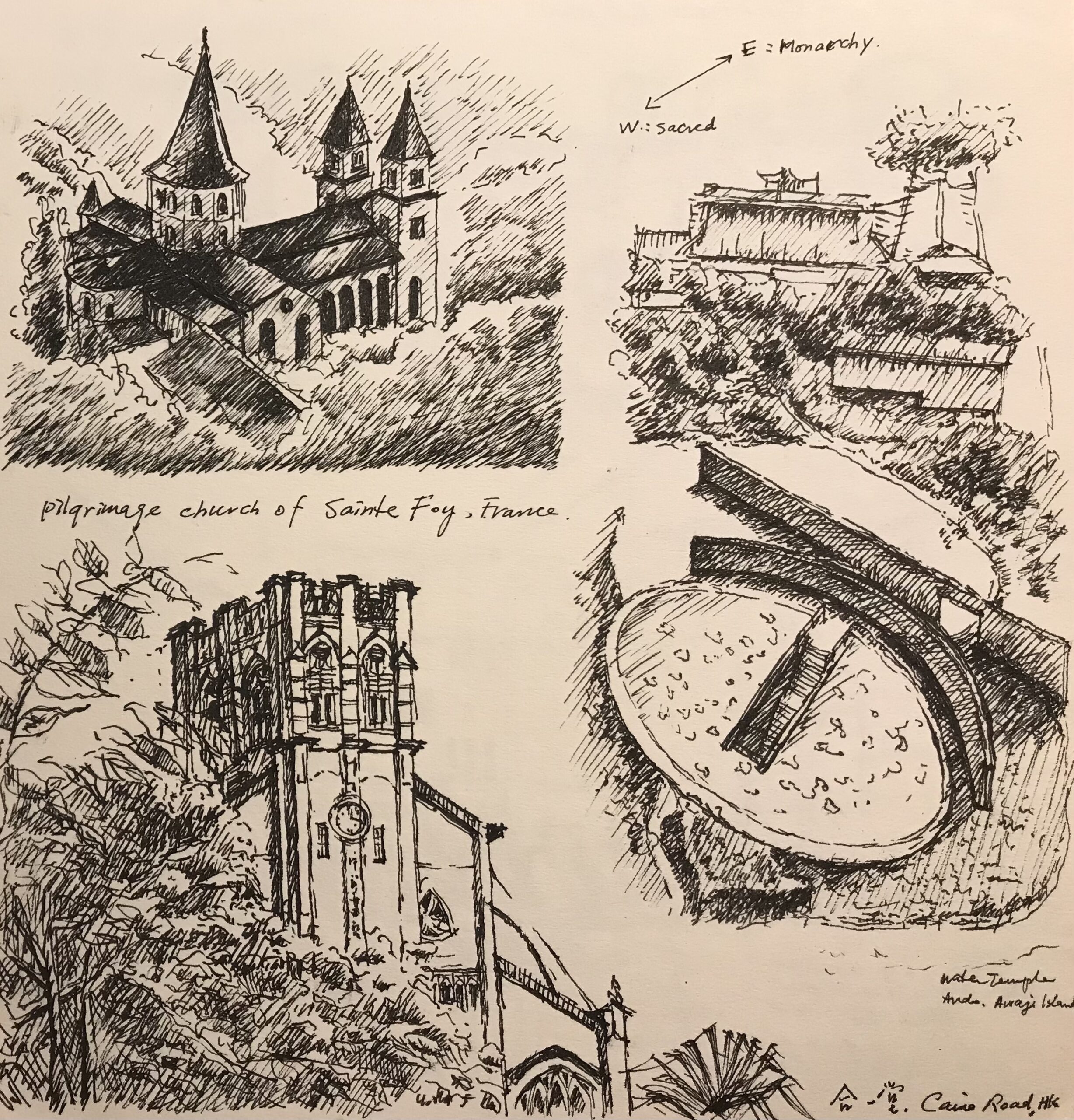
May’s sketches of various buildings in France, Japan, and Hong Kong.
This work ethic overlaps with May’s artistic process in the sense that her sketches begin with ‘bigger picture’ concepts, like lines and shapes, and gradually moves towards finer details, though she often takes a step back to ensure that both the bigger picture and smaller intricacies are balanced and in harmony. She applies this process to all projects she undertakes, explaining, “If somebody gives you a task or big issue, it’s helpful to break them down into steps to tackle them one by one, rather than being overwhelmed by it. After you finish, always stand back and question the work, then you’ll find your own mistakes without other people telling you.”
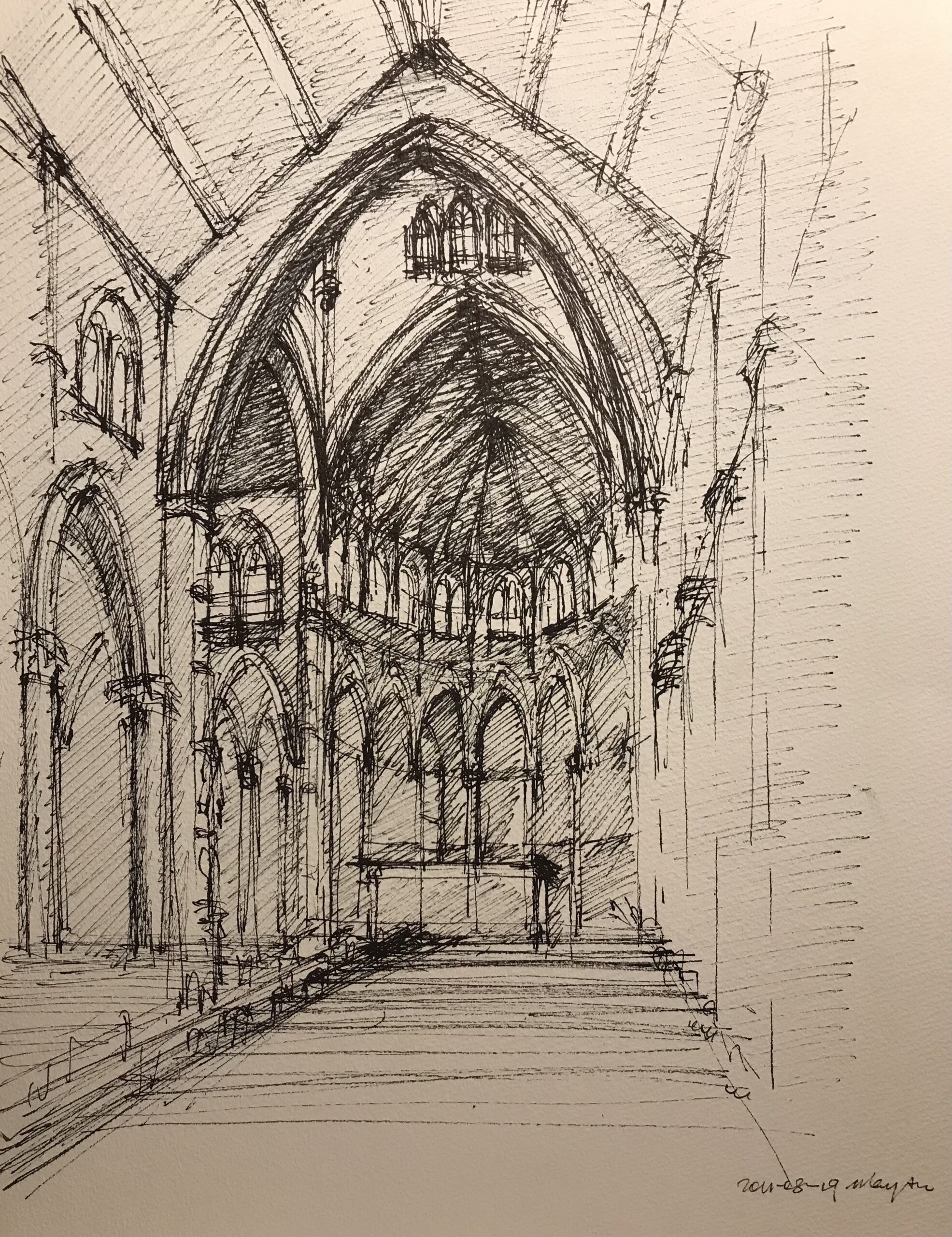
May’s sketch of Immaculate Conception Cathedral in Hong Kong.
Illustration is not the only artistic talent that May holds. Before becoming an architect, she made and sold pottery. May disclosed, “I couldn’t make a living out of pottery, so my sister suggested that I look into architecture. I thought ‘ohh, that’s so different because clay is so soft and so flexible, and architecture is not.” Though she no longer makes pottery, her love for the craft remains. May views herself as more of a potter than an architect. “I don’t [do pottery] anymore, I get addicted to it,” she jokes. “I cannot stop. A few days ago, I found a pottery studio in my neighborhood. I was too excited; I couldn’t fall asleep.” In addition to her past as a potter, May has taken classes on Chinese calligraphy and oil pastel painting throughout her architecture career, and illustrates cartoons for her church’s newsletter.
One of her dreams was to become a rendering artist, however, since rendering is no longer done by hand, May pivoted to learn more about detailing, a decision which brought her – at the suggestion of a friend – here, to Ankrom Moisan. May saw this opportunity as a way to build a solid foundation in the field of architecture, as well as a chance to be exposed to a more diverse range of projects than previous positions she had held.
May says that she has learned to be more efficient, as well as the art of detailing, since starting at Ankrom. “I’m very thankful to mentors like Sean Scott, James Lucking, and David Dahl that really helped with my detailing,” May said. “Without them, I wouldn’t be able to do much, or wouldn’t be able to [detail] correctly.” She believes that her attitude has changed too. “I’ve learned to be more patient. Patient of my own growth,” she reflected.
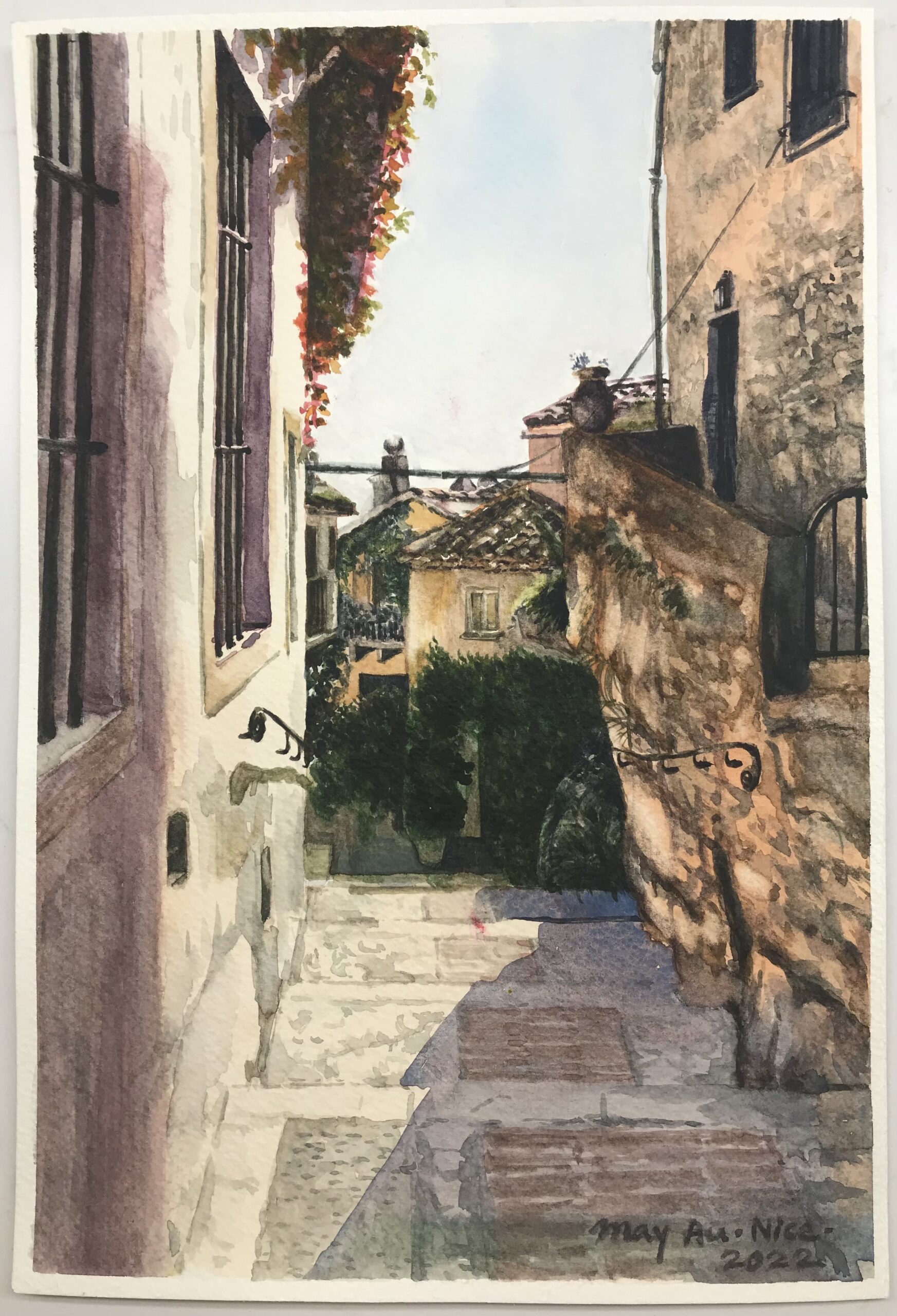
A watercolor painting of an alleyway in Nice, France, completed by May in 2022.
Though she primarily works on residential projects, May’s favorite type of work are cultural buildings “that are for public use,” she says. “Residential buildings are what we do, and they’re my second favorite type of architecture since we eat and live in those buildings every day.”
As an architect, May is inspired by the ability to “explore the possibilities in a space and to be creative and not necessarily stuck with what we see, but to come up with many different ideas.” As for her art, she finds that her creative impulse is sparked by the mood and the lighting in the composition of an image. While there is not a single subject May does not enjoy drawing, she wants to improve her portraits, since they can be so challenging. “It takes a lot of work. If I can draw people’s emotions, and capture that [essence] where it’s like ‘that person looks like that person,’ I’d be happy,” she explains.
May has plenty of sage advice for young professionals who are just starting out in the field of architecture and interior design. She stresses patience with oneself and self-confidence. “People blossom at different stages, so don’t be too impatient with yourself,” she says. “Learn to be humble, but at the same time, learn to be a leader. Know your own strengths. Know what kind of path you want to go down, and fight for it. Don’t let other people decide what you can do.” May also acknowledges the virtue of tenacity, stating “we have to fail before we succeed.” As a final piece of wisdom, May offers, “be able to learn to embrace the details, not just ideas,” a philosophy that she clearly lives by, evidenced by her beautifully detailed illustrations.

By Jack Cochran, Marketing Coordinator






